2023-06-05 发布
本帖最后由 金铭 于 2023-6-6 17:28 编辑
项目概况
Project overview
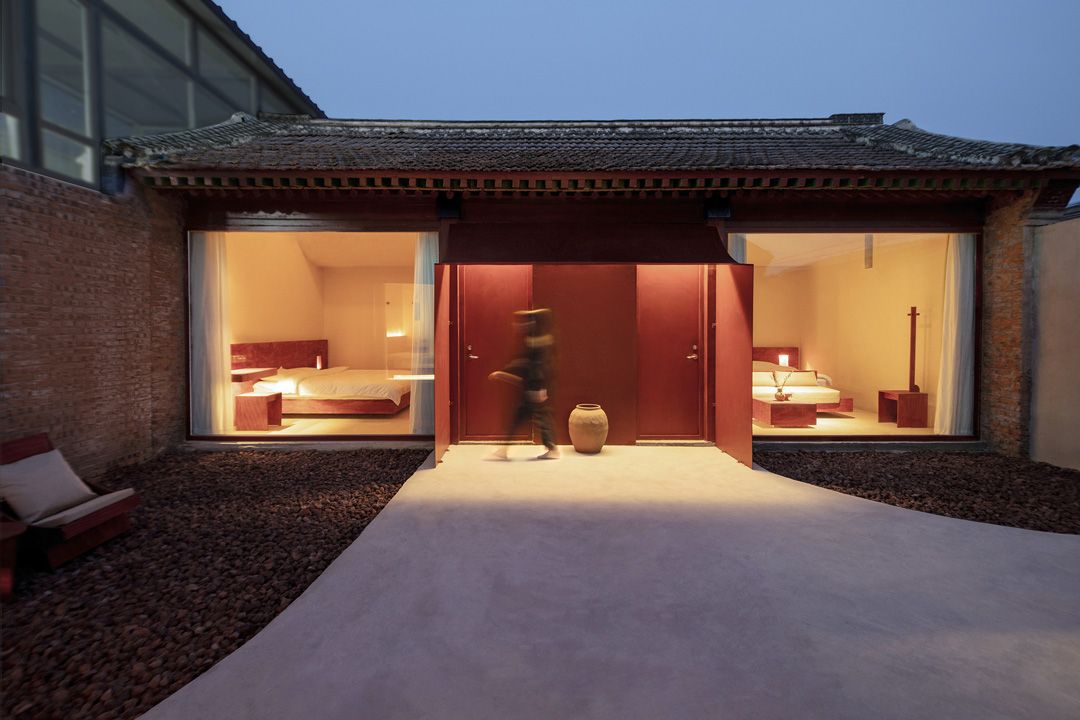
项目位于北京市通州区唐大庄村,一个保存着北方传统平房建筑形态的村庄。这里的房子由红砖砌成,具有中国古建筑的元素,彩绘图案,木结构的坡屋顶等传统特征。对这些传统建筑特色的提取与重构,是一项富有挑战性的设计任务。多么工作室受委托将原本总面积只有80平米的平房和小院改造成了一个精品民宿酒店,意在原始建筑和场地的特色条件下,以现代几何元素注入全新的内核,重塑建筑脉络,实践对传统建筑的重新想象。
The project is located in Tangdazhuang Village in Tongzhou District, Beijing is a village that preserves the traditional northern flat house architectural style. The houses here are made of red bricks and have elements of ancient Chinese architecture such as painted patterns, wooden structure sloping roofs, and other traditional features. Extracting and reconstructing these traditional architectural features is a challenging design task. Atelier d’More was commissioned to transform a small flat house and courtyard, with a total area of only 80 square meters, into a boutique hotel, injecting new modern geometric elements into the original architectural and site characteristics, reshaping the architectural context, and practicing a new imagination of traditional architecture.
▼区位图,location map©atelier d'more

▼平面图, floor plan©atelier d'more
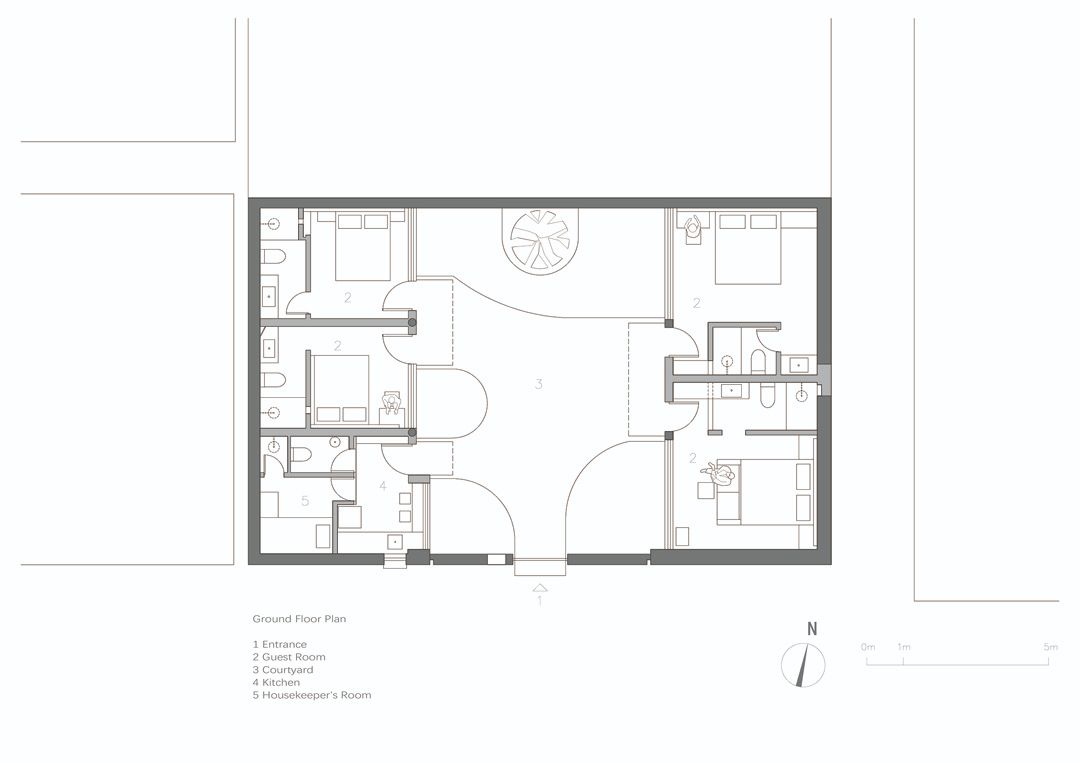
▼暮色下院子总览,Overview of the courtyard at dusk
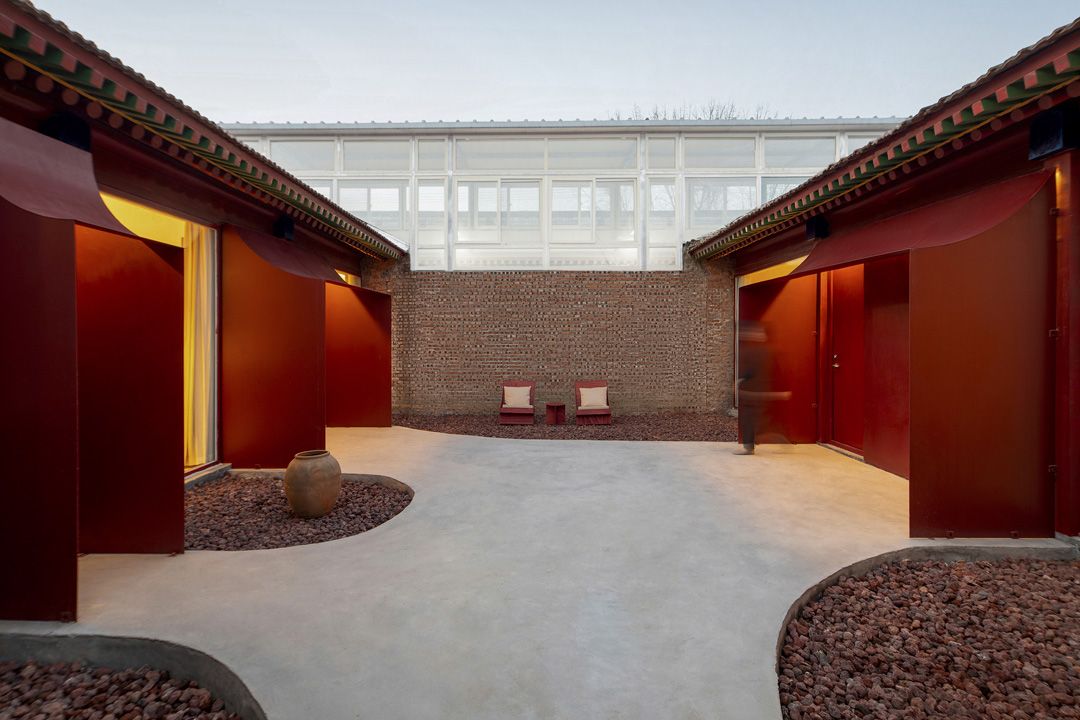
▼幕色下的客房近景,Close-up of the guest room in twilight

重构
Reconstruction
在这次改造中,我们希望保留传统建筑的痕迹,并在现代语境下赋予新的意义。保留屋檐的经典元素,同时简化彩绘,使传统元素在整个建筑中成为抽象的表现形式。
In this transformation, we hope to preserve the traces of traditional architecture and give them new meaning in a modern context. We retain the classic elements of the eaves while simplifying the painted patterns, making traditional elements an abstract expression throughout the entire building.
▼改造前的建筑,The building before renovation
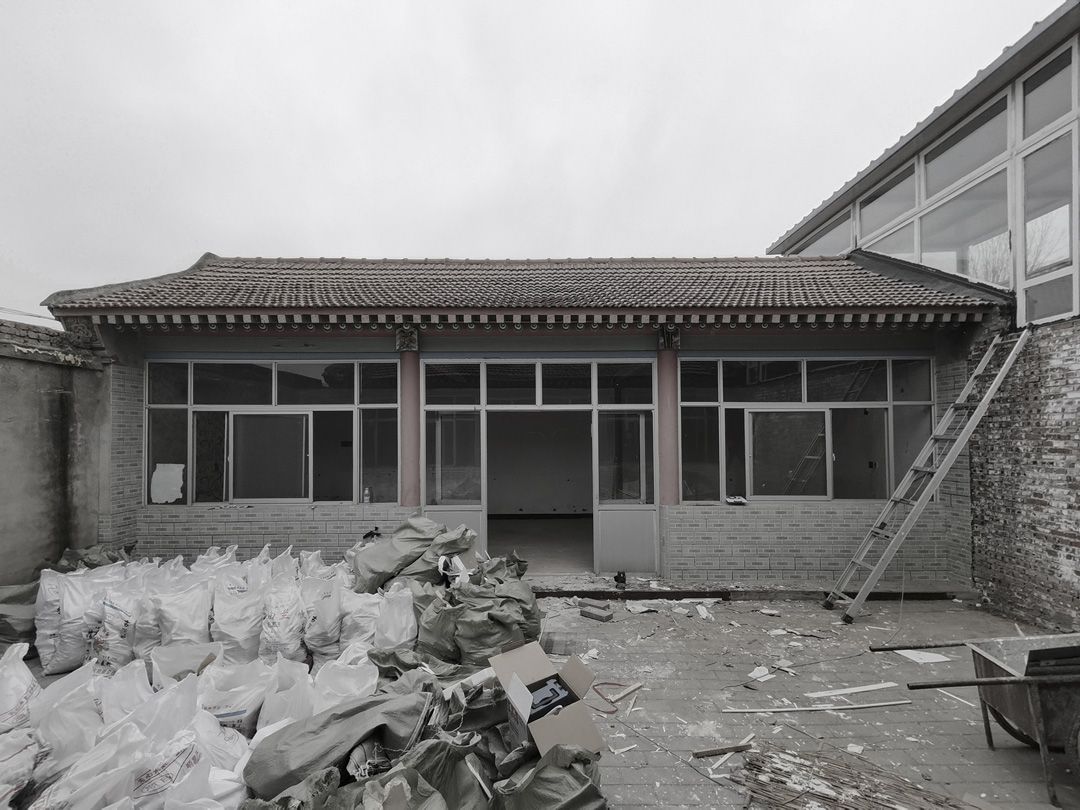
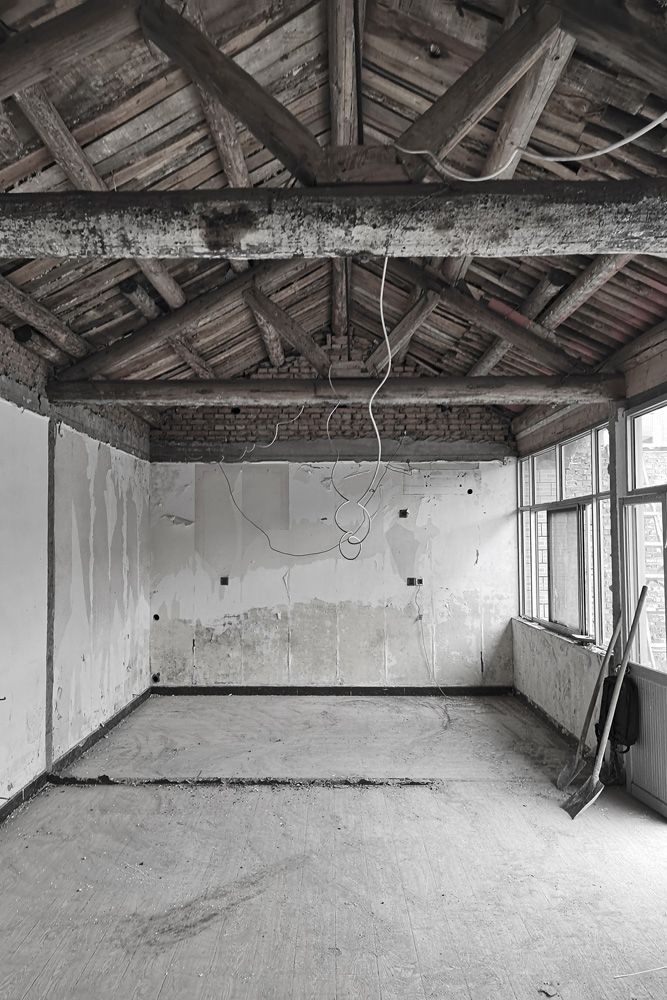
▼分解轴测图,exploded axonometric©atelier d'more
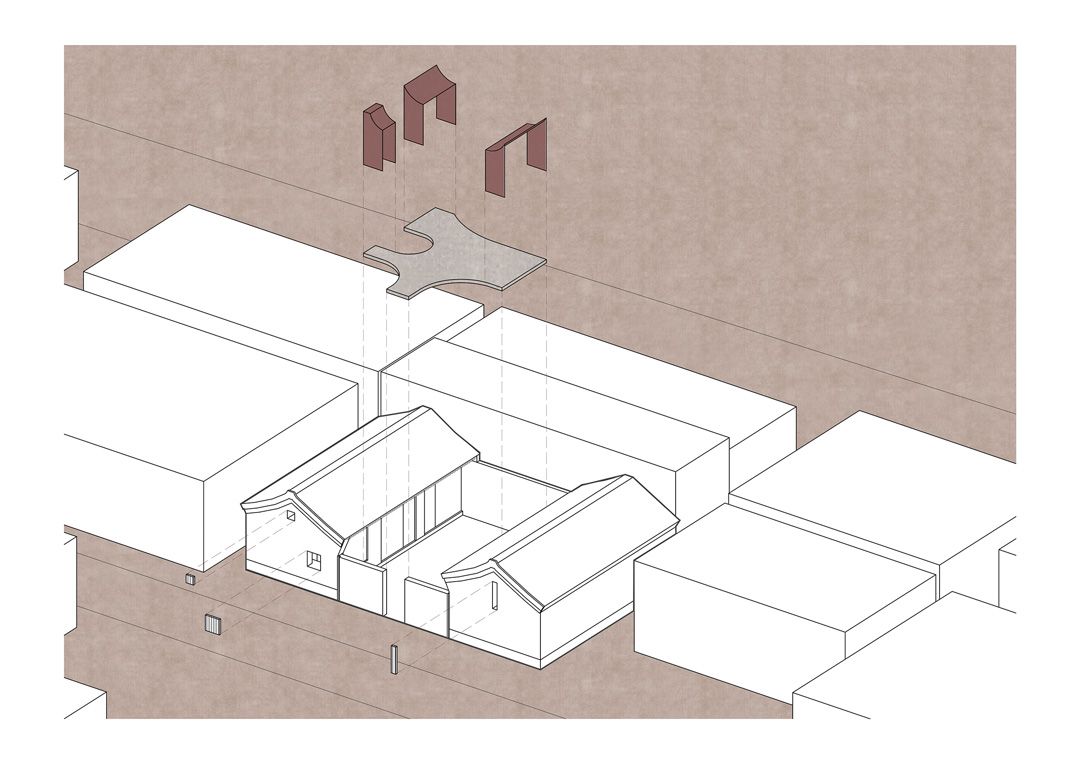
▼保留的原始红砖墙和为项目设计的躺椅,Preserved original red brick wall and custom-designed lounge chairs
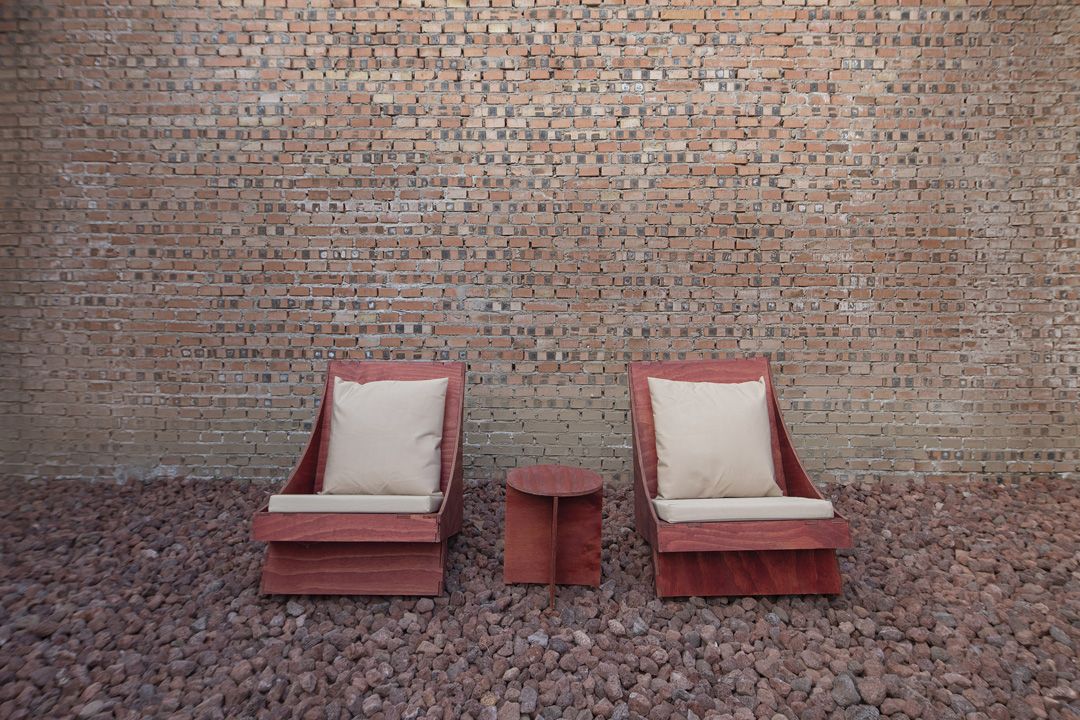
▼彩绘屋檐下建筑的延续,Continuation of the architectural design under the painted eaves
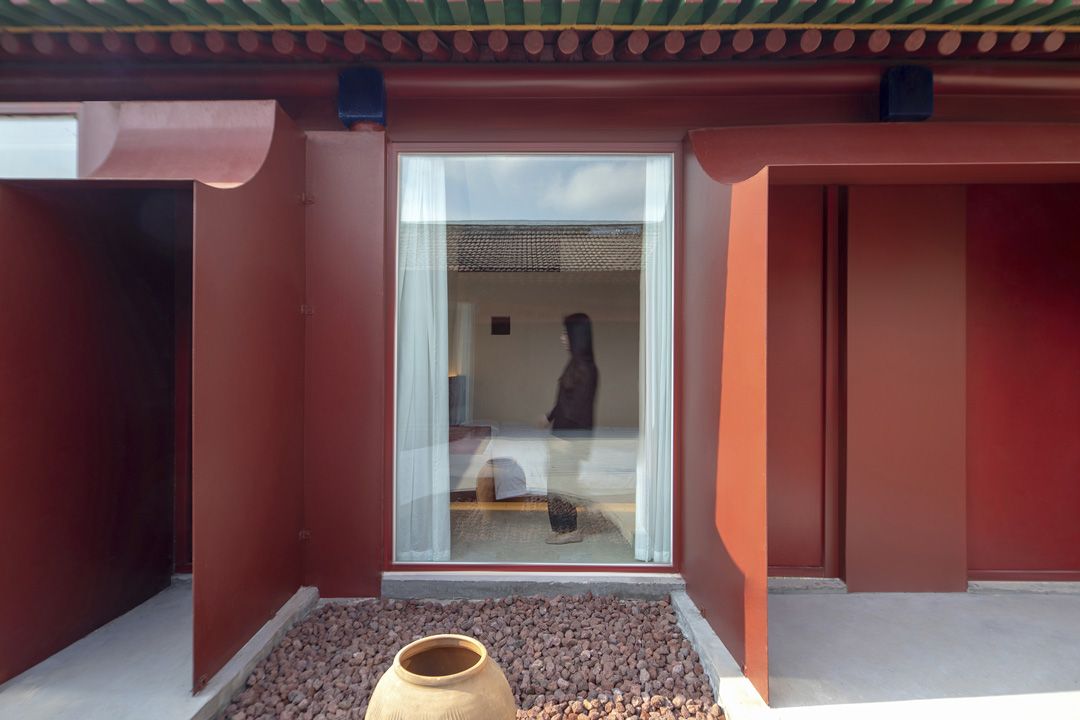
▼阳光下的红色入口,Red entrance in the sunlight
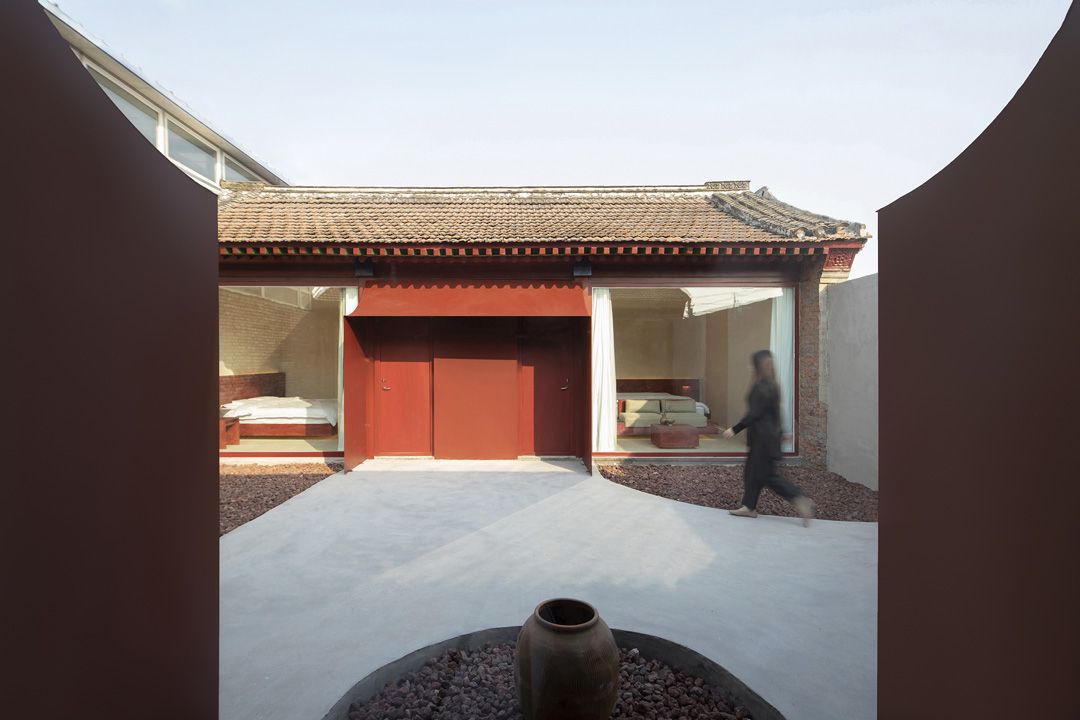
为了给空间注入灵魂,我们提取了原始建筑中的红色,并进行了色度的调整,将其定义为此项目的主调,颜色从此不再是视觉体验,而是精神性的表达。在建筑的外立面和室内家具中,以适当的比例贯穿其中,就像一个微妙的音符,为整个项目带来了一种诗意的氛围。
In order to infuse the space with soul, we extracted the red color from the original architecture and made adjustments to its hue. We defined it as the main tone of this project, transforming the color from a mere visual experience into a spiritual expression. It is tastefully integrated in appropriate proportions throughout the facade of the building and the interior furniture, acting as a subtle note that brings a poetic atmosphere to the entire project.
▼黄昏下的东厢房立面,Facade of the east wing at dusk
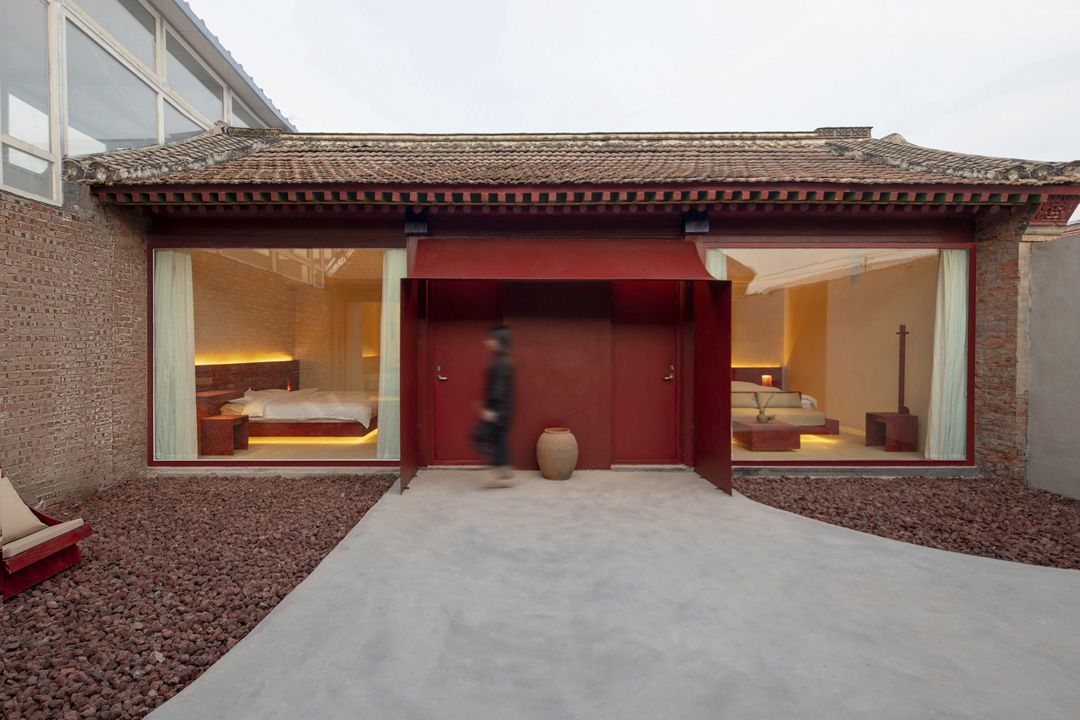
▼暮色下的西厢房立面,Facade of the west wing at dusk
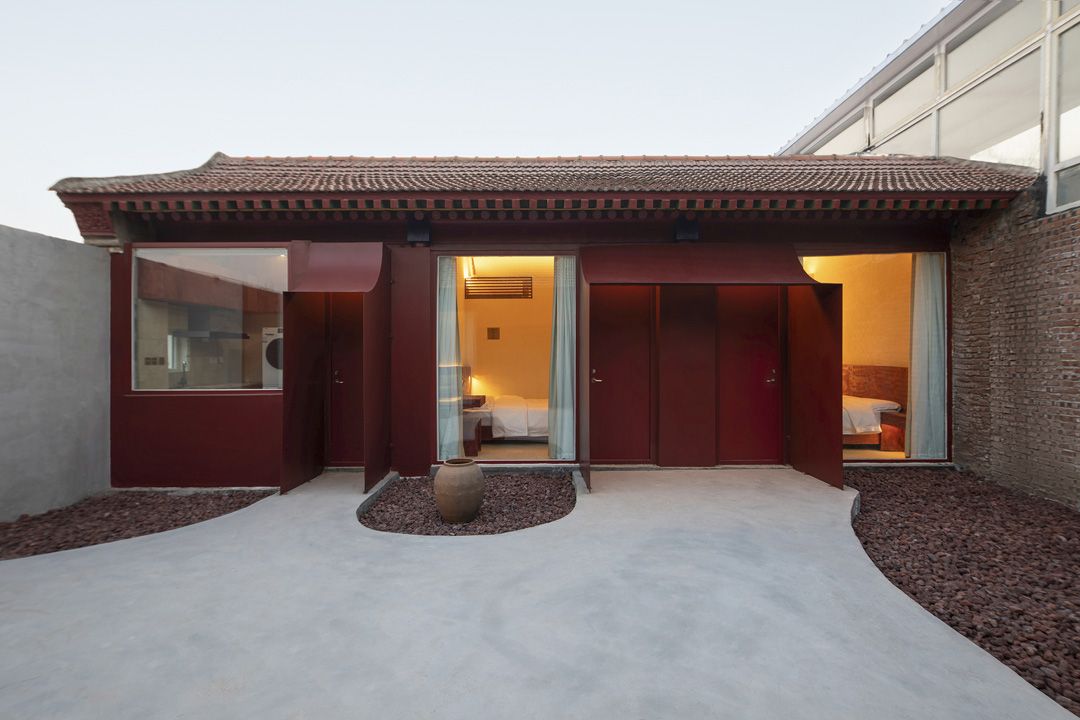
▼东厢房客房概览,Overview of the guest room in the east wing
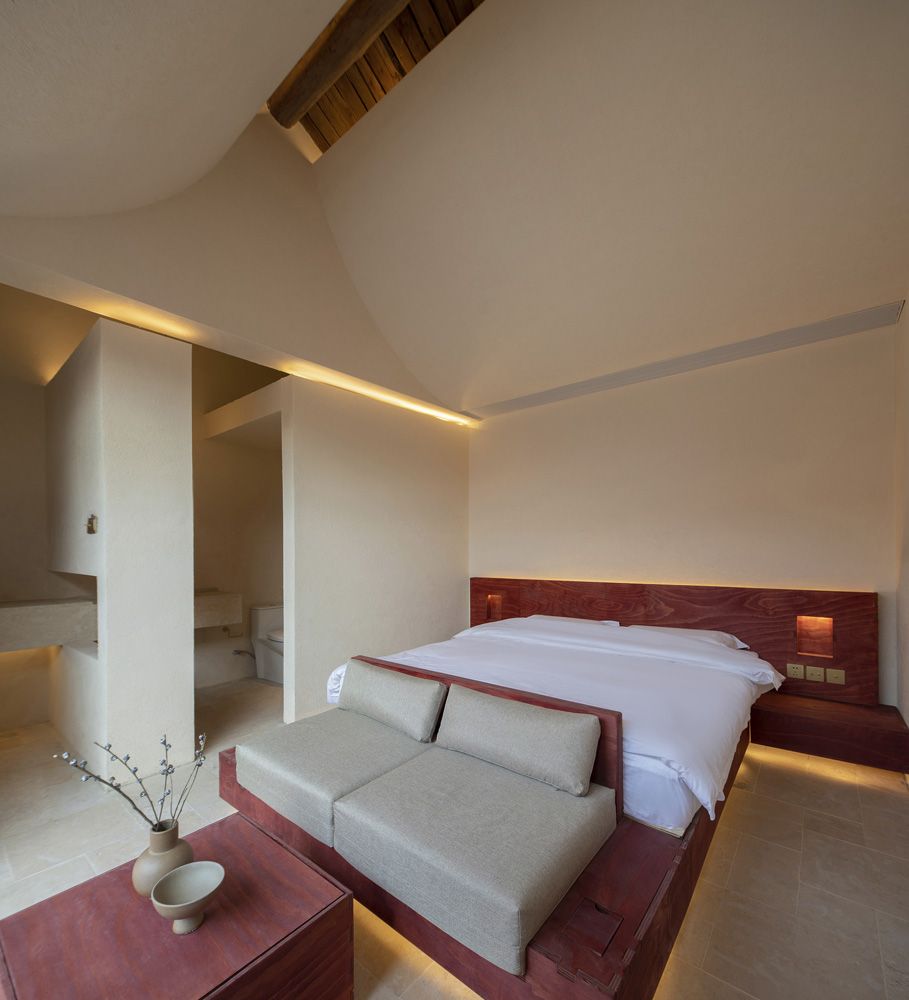
▼床头壁龛细部,Detail of the niche above the bedside
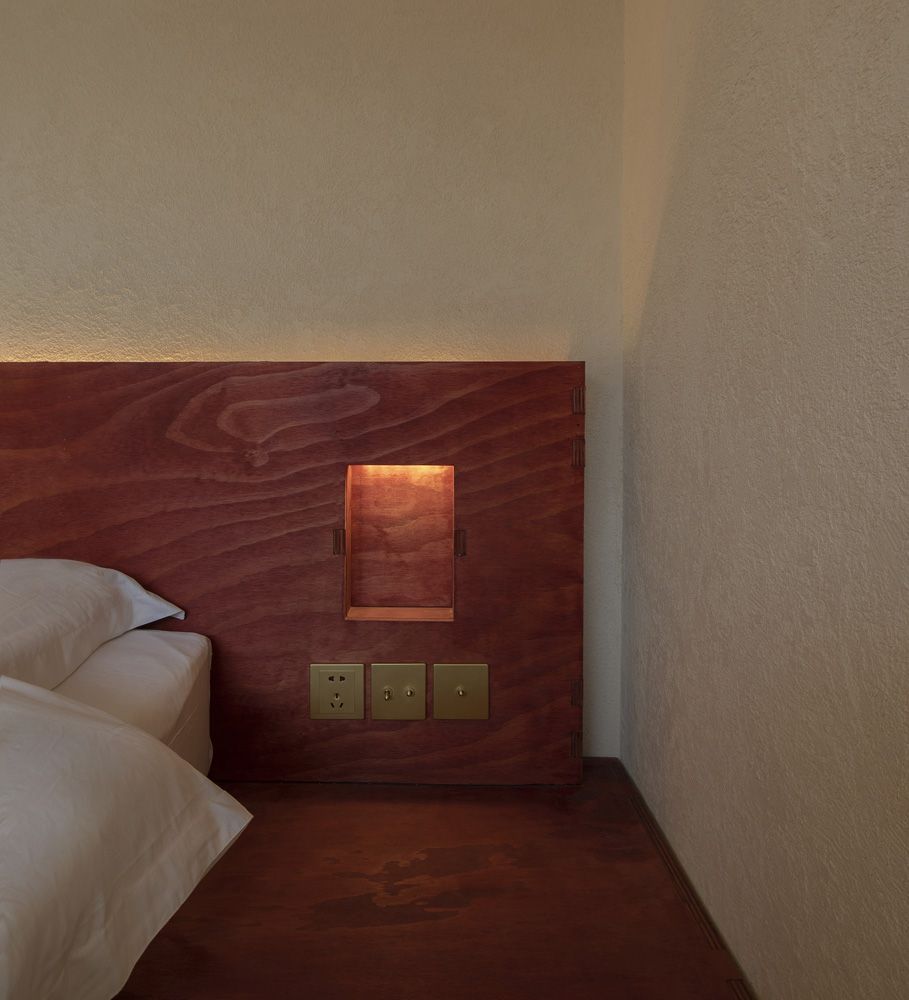
我们在庭院中引入一条主轴,以曲线的形式勾勒出几条岔路,分割出四个不同尺度的内部庭院。在视觉上营造出空间层次感,也在功能上实现了灵活性和可变性。红色火山石铺就的景观区为建筑增添了一抹别致的色彩,而水泥路面则流向各个客房空间,引导着客人行走的方向和空间范围。此外,我们用具有张力的几何形状构建了客房入口,使其具有一种新京味儿的入场仪式。室内原本面向院子的墙体被拆除后,大面积的落地玻璃代替了相对封闭的窗墙体系,室外庭院与室内空间就此成为交替的风景。
We introduced a main axis in the courtyard, delineating several branching paths in curved forms, creating four distinct internal courtyards. This arrangement not only creates a sense of spatial hierarchy visually but also achieves flexibility and adaptability in terms of functionality. The landscape area paved with red volcanic stones adds a touch of elegance to the architecture, while the cement pathways flow towards the different guest room spaces, guiding guests in their direction and spatial range.
Furthermore, we designed the entrance of the guest rooms with tension-filled geometric shapes, creating a unique entrance ritual with a touch of local charm. After removing the walls that originally faced the courtyard, large floor-to-ceiling glass windows replaced the relatively enclosed window-wall system, blurring the boundaries between the outdoor courtyard and the indoor space. This way, the outdoor courtyard and the indoor space become alternating landscapes, seamlessly connected and offering captivating views.
▼院子入口区域,Entrance area
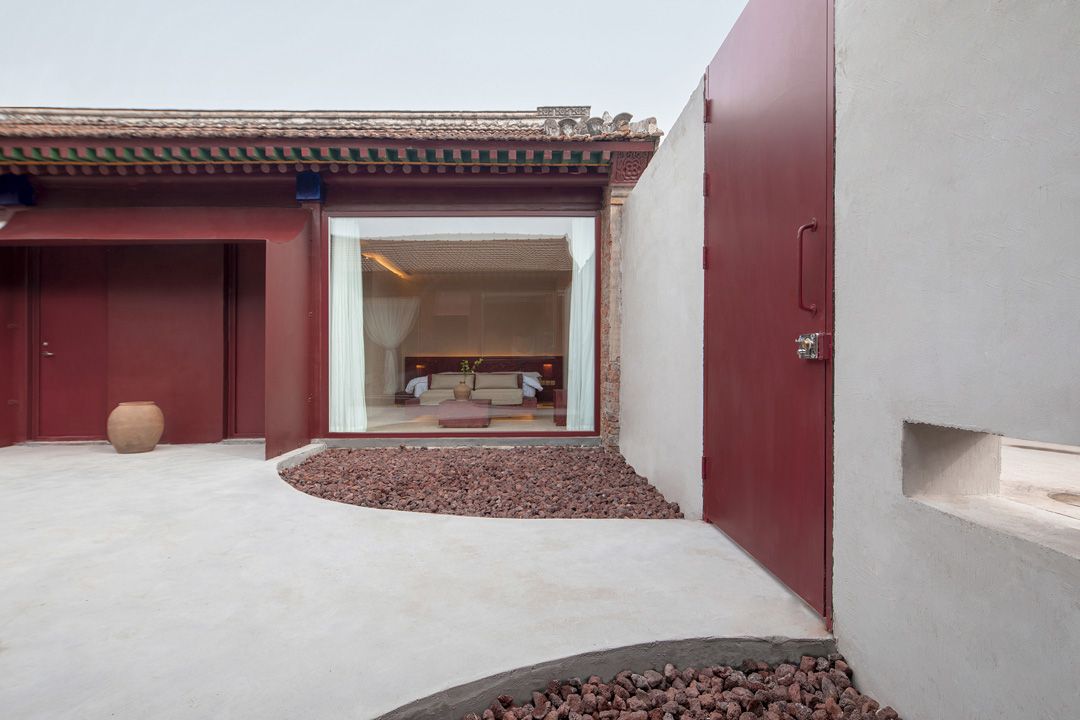
▼弧形走道流向入口,Curved pathway leading to the entrance of the guest rooms
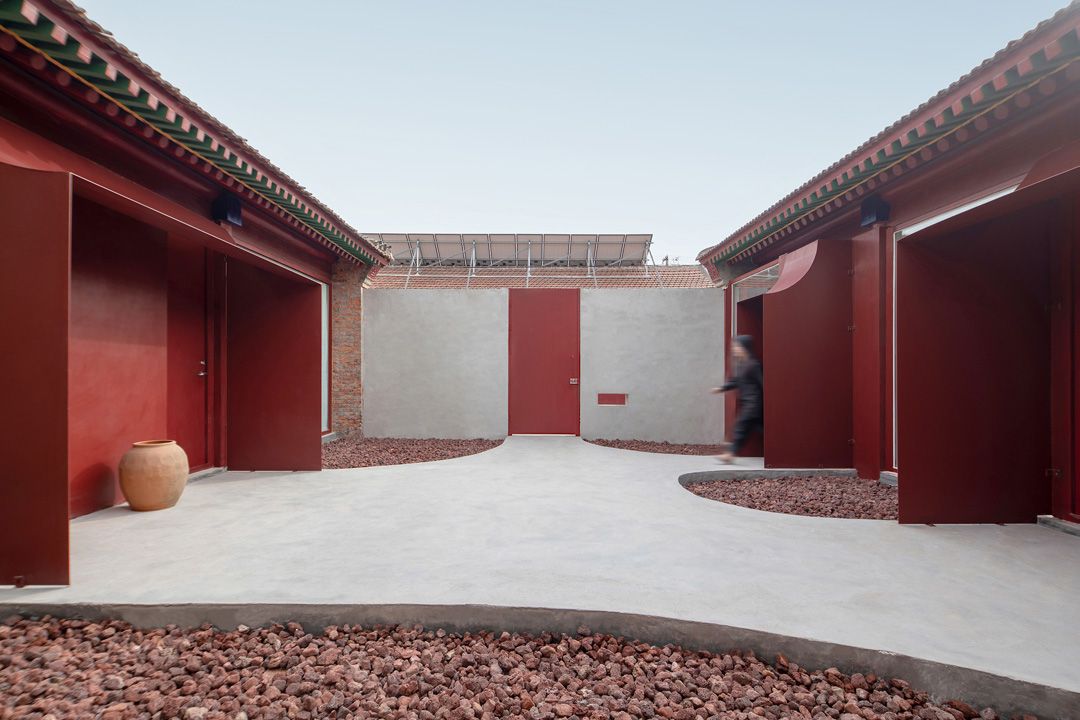
▼客房入口秩序,Order at the entrance of the guest rooms
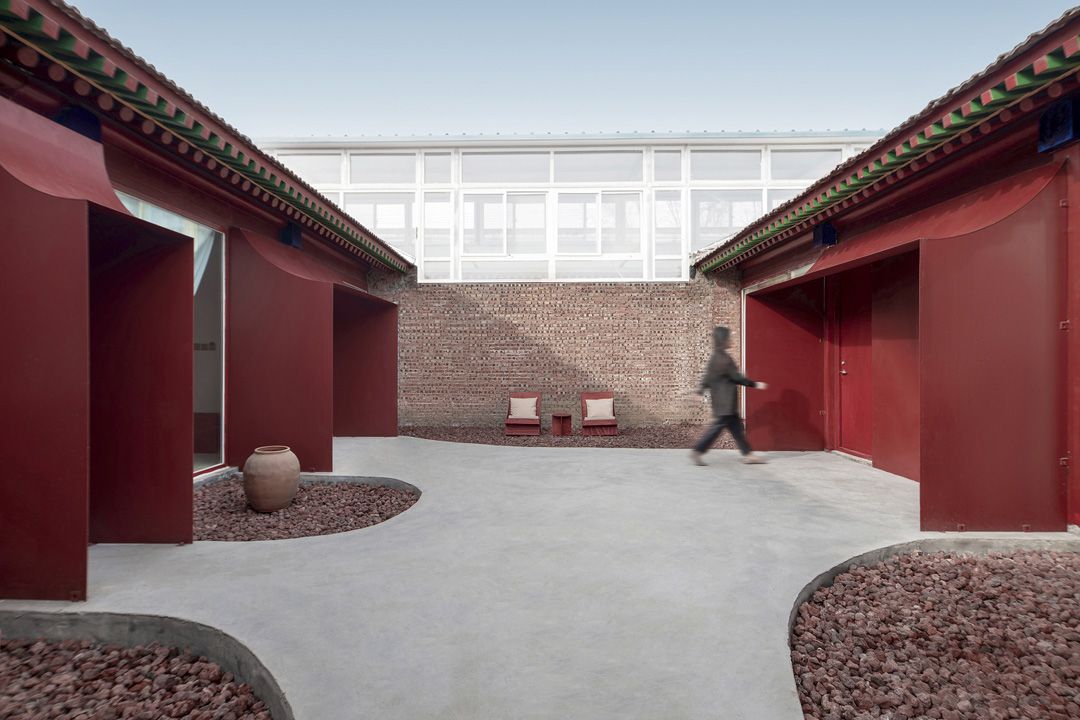
▼屋檐下的视角,Perspective under the eaves
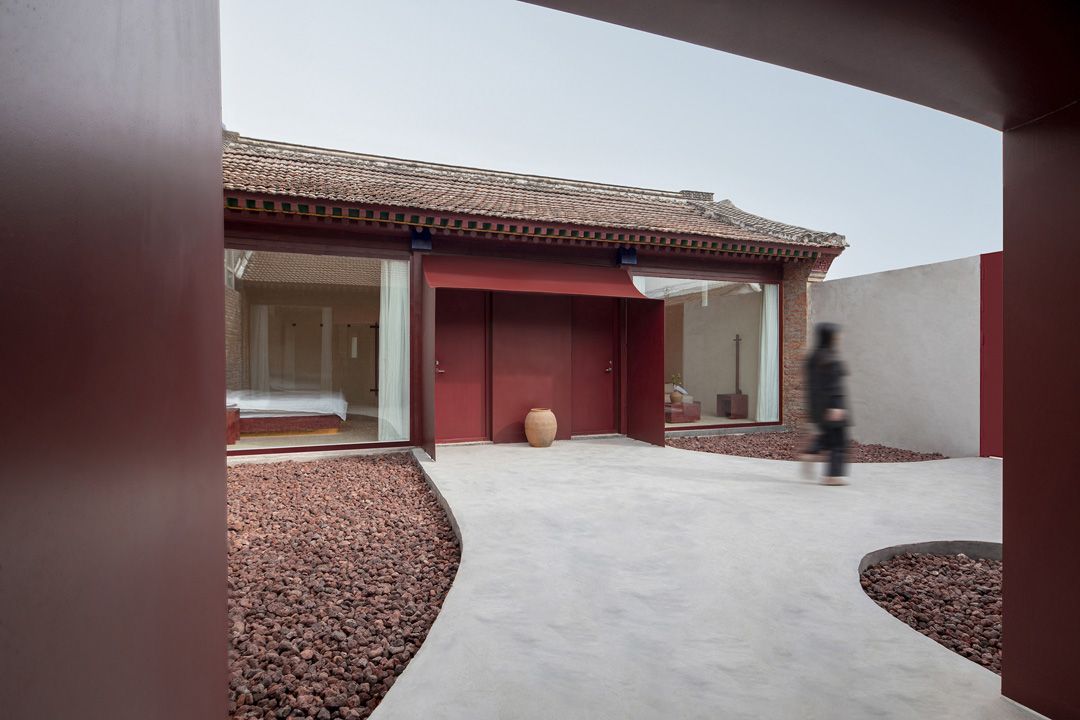
▼屋檐下看向大门,View from under the eaves towards the entrance gate
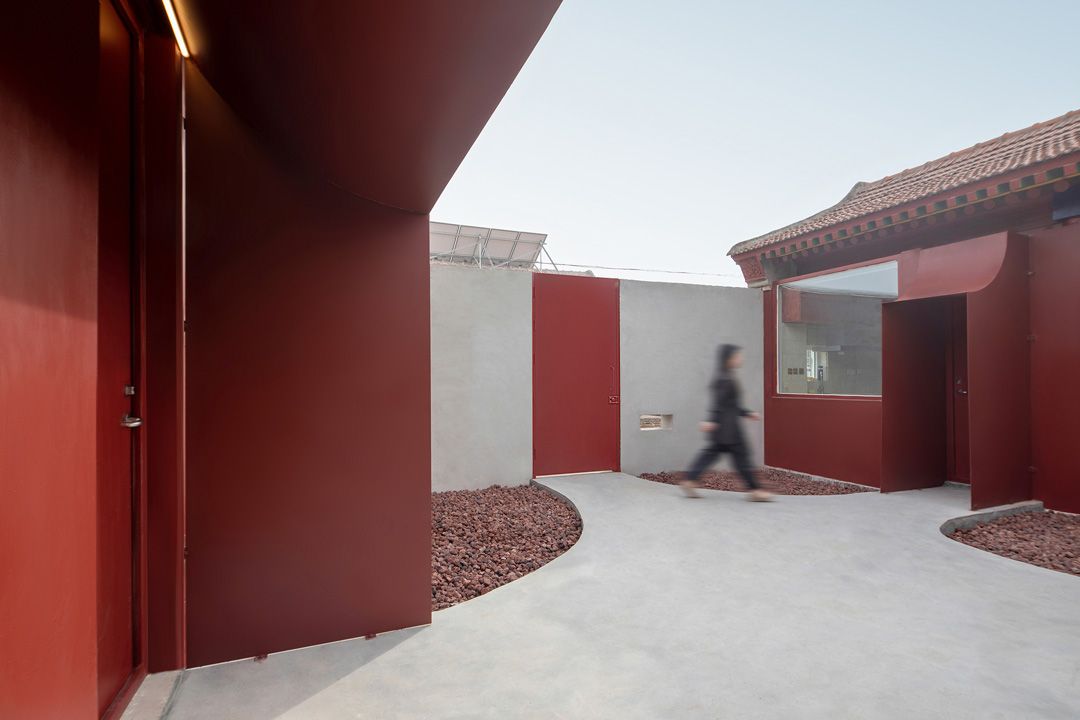
▼东厢房入口立面,Entrance of the east wing
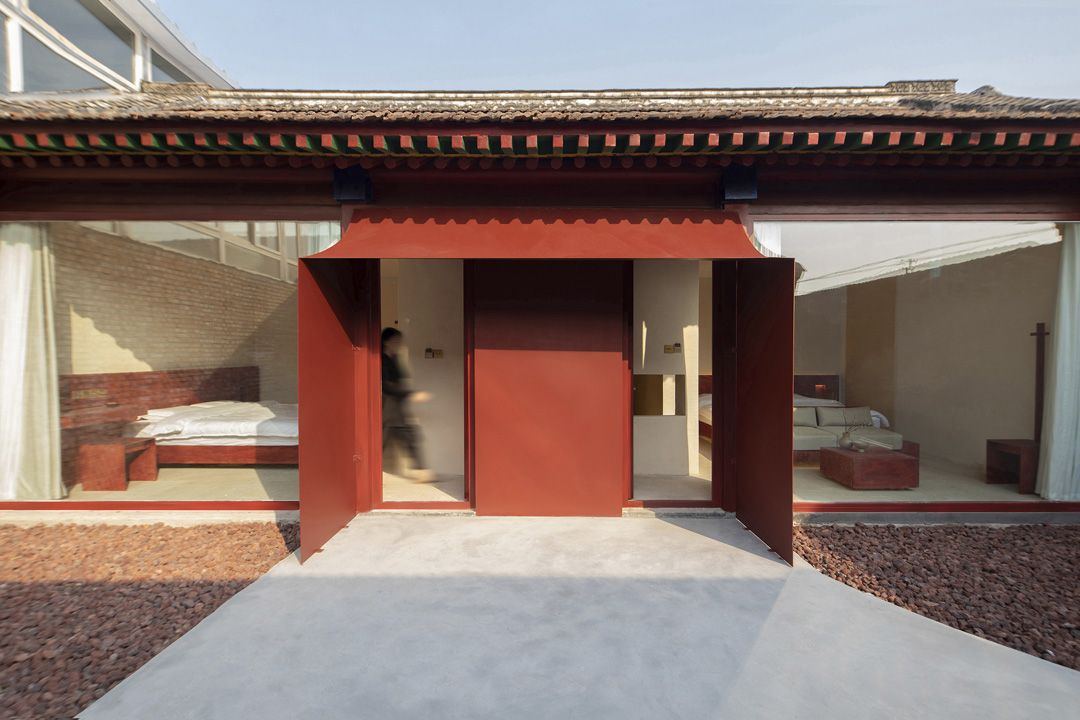
▼西厢房立面,Facade of the west wing
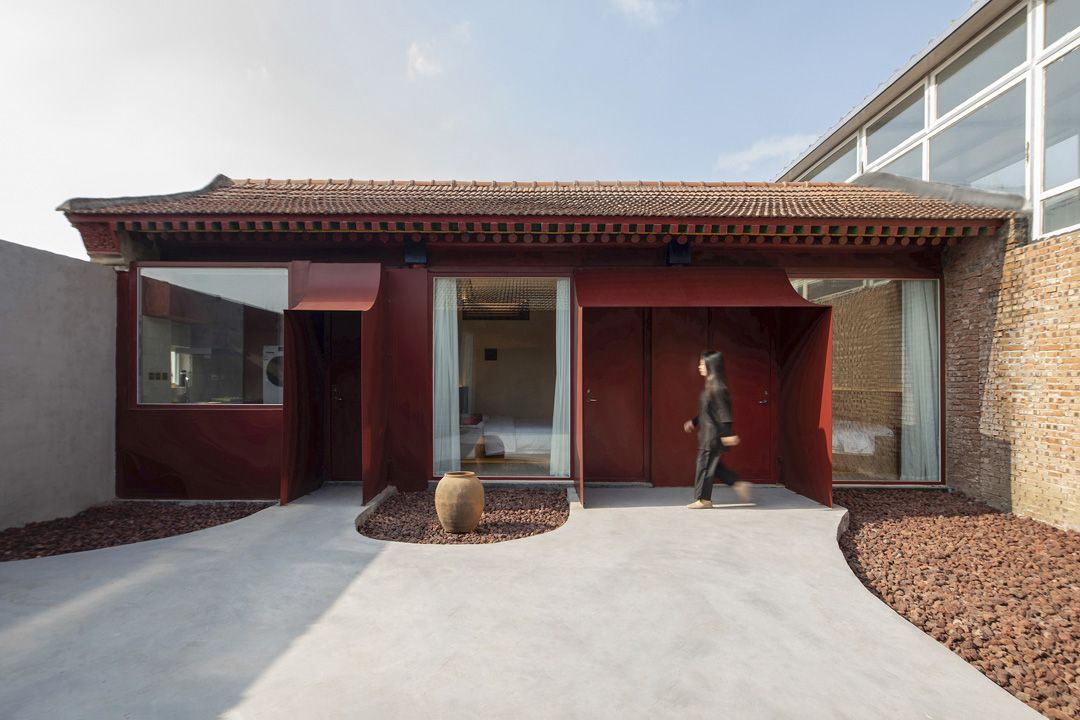
▼传统建筑下的新内核,New core within the traditional architecture
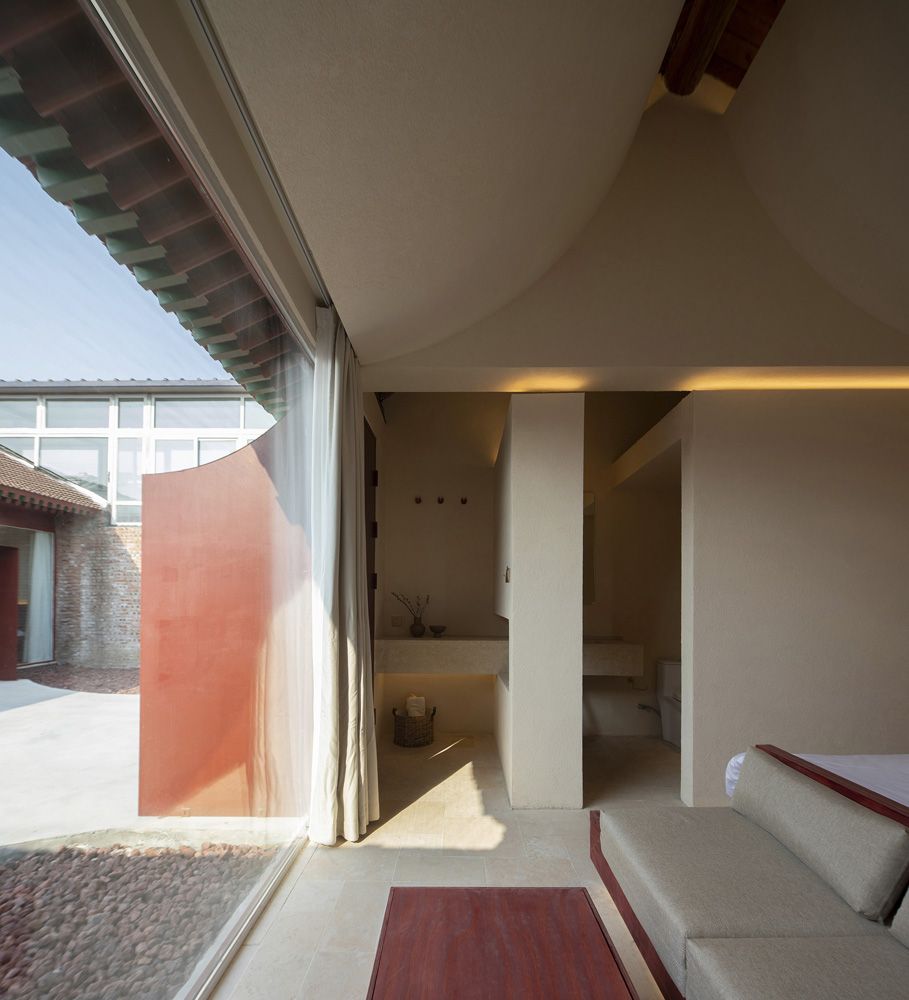
我们试图在现代的脉络里展现古老的韵律,用空间让时间的记忆共生。在旧有建筑的坡屋顶下,将屋脊部分打开,展露出原有的木梁,又在屋顶剖面关系上做出变化,用曲面勾勒出传统的坡屋顶形象,将古老的建筑语言融入现代的空间里,让历史在现代里得以传承。在这个4.1米挑高的空间下,我们设计了柔和的间接照明,每一条光线都在勾勒空间的轮廓,给人以具有精神性的空间体验。
We strive to showcase ancient rhythms within a modern context and allow the coexistence of time's memories through spatial design. Under the sloping roofs of the existing buildings, we opened up the ridge section to reveal the original wooden beams. We also made changes to the roof profile relationship, using curved surfaces to outline the traditional sloping roof image. This integration of ancient architectural language into modern space ensures the inheritance of history within the contemporary setting. In this 4.1-meter high space, we have designed soft indirect lighting. Each beam of light outlines the contours of the space, providing a spiritual experience within the environment.
▼山墙上的条形窗,Striped windows on the gable wall
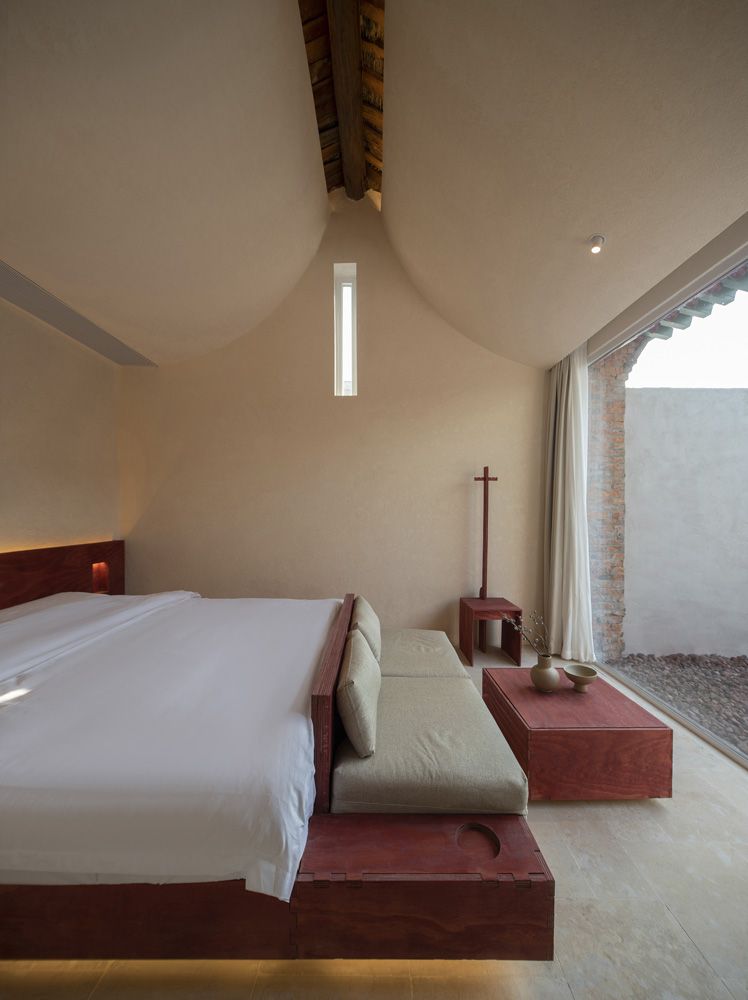
▼外露的原始木屋顶,Exposed original wooden roof
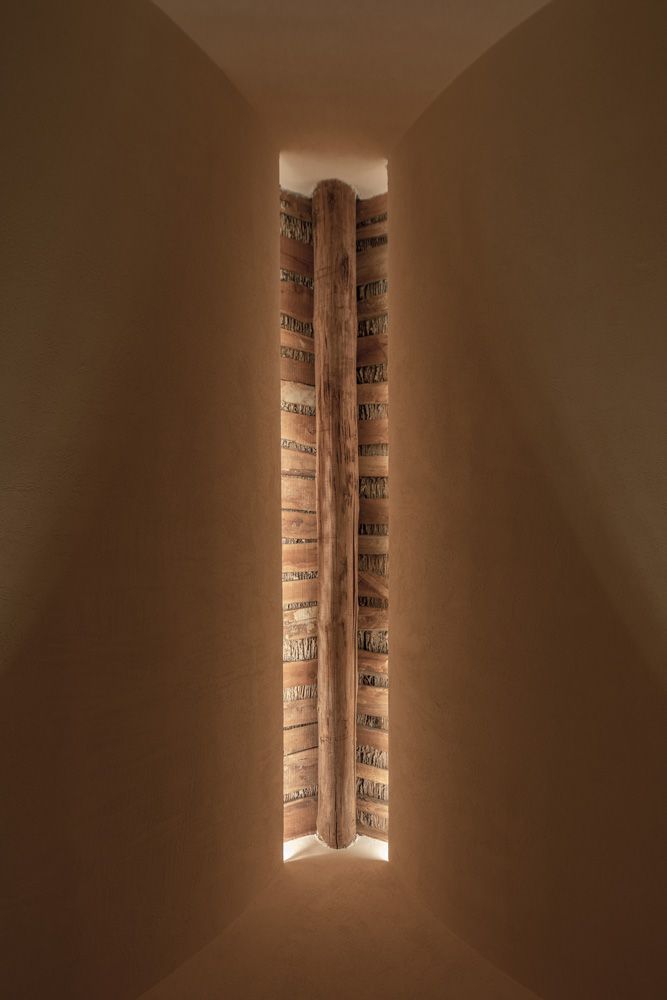
▼东厢房客房人字吊顶,Herringbone ceiling in the guest room of the east wing
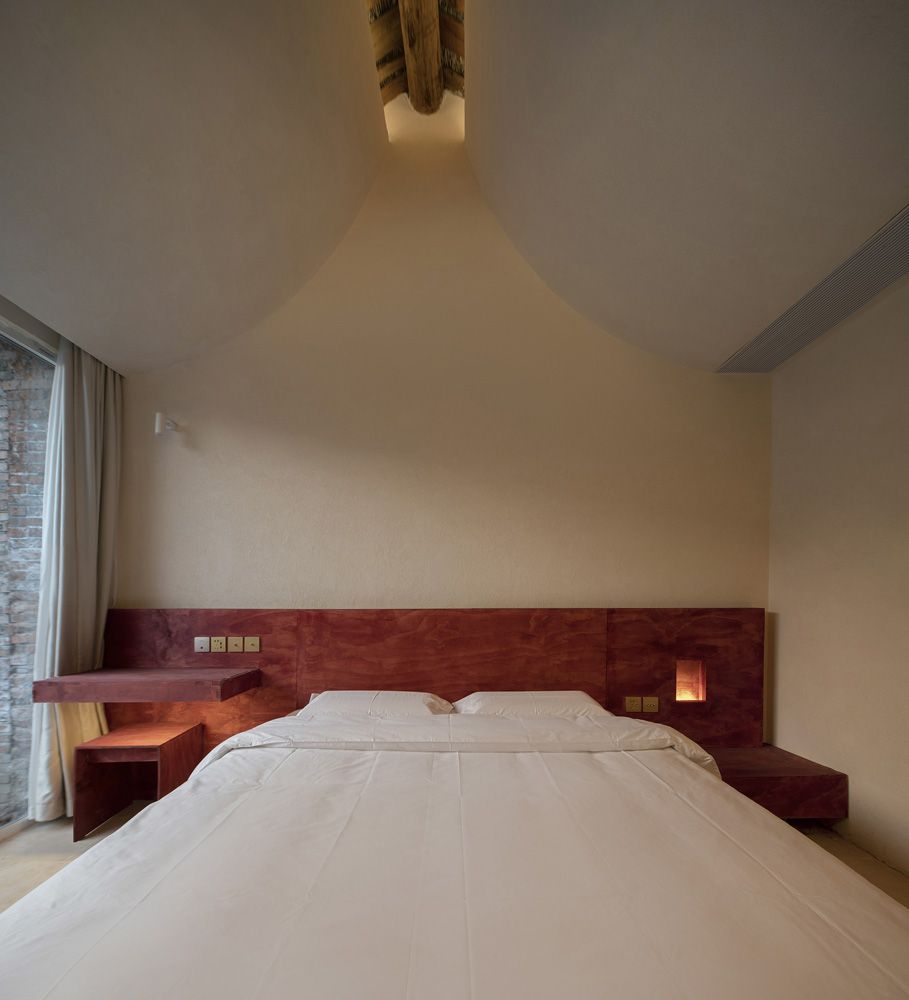
▼人字吊顶与自然光,Herringbone ceiling and natural light
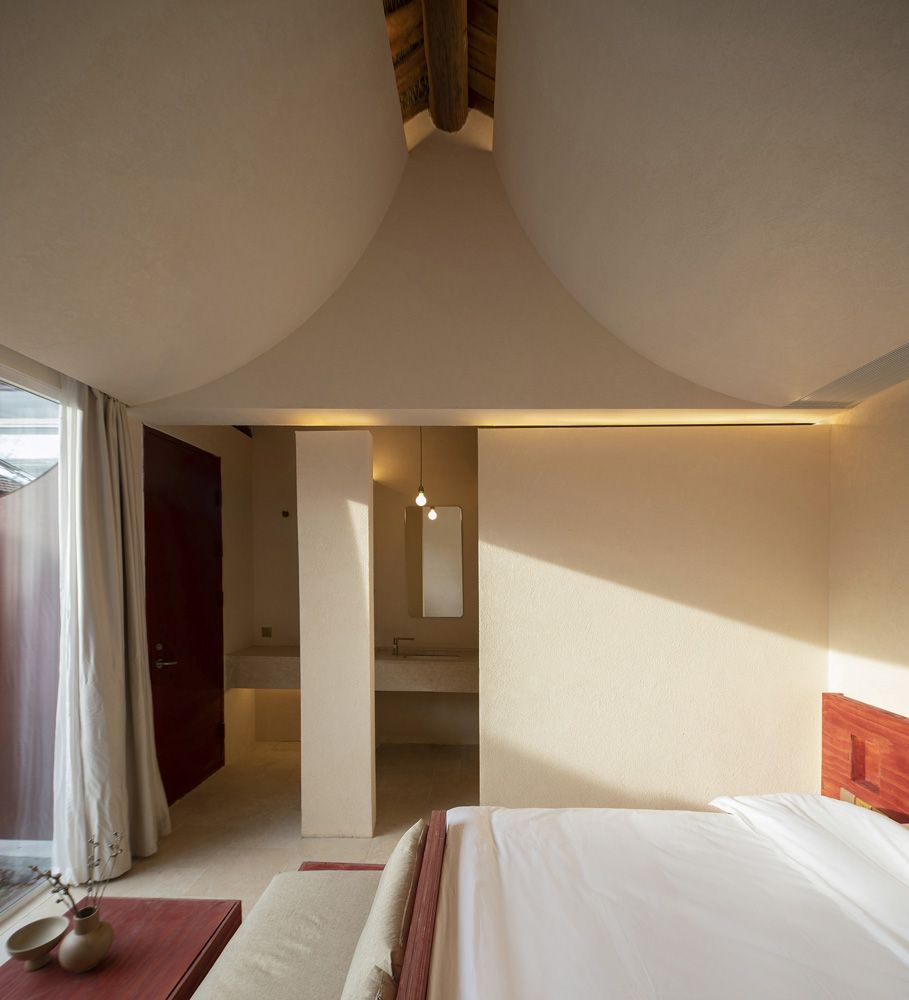
▼人字顶的光影效果,Light and shadow effects of the herringbone ceiling
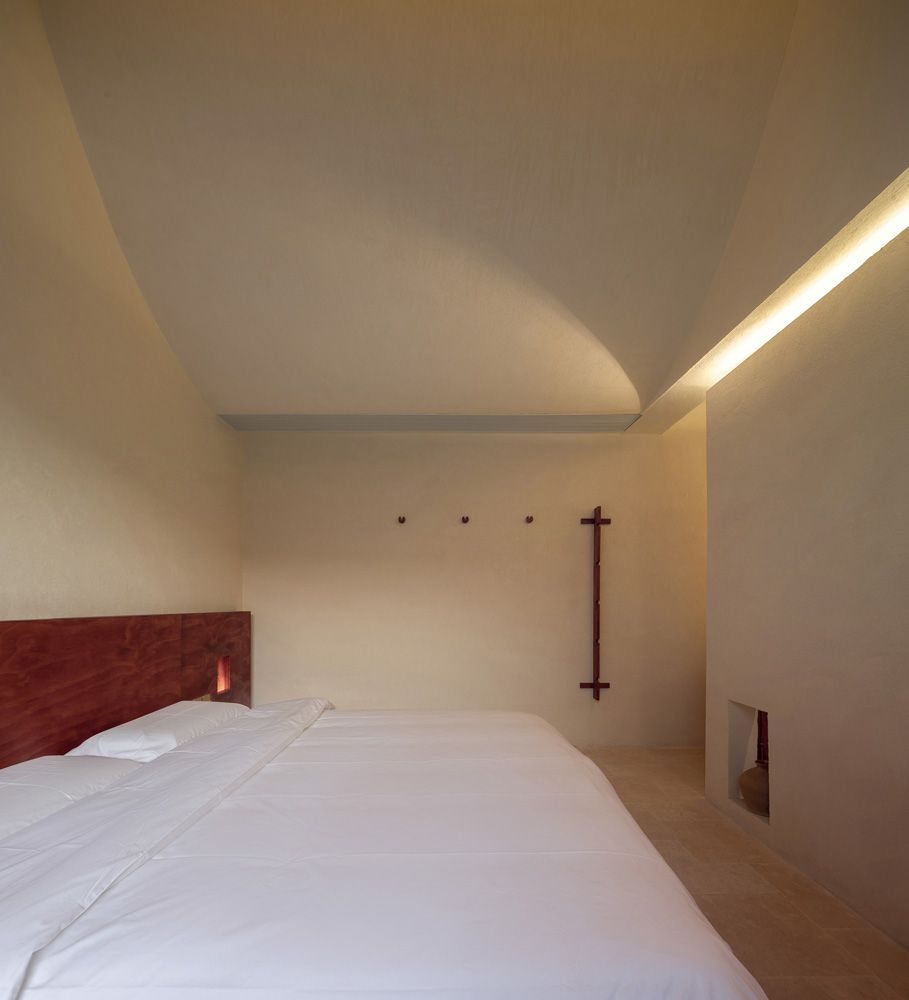
▼西厢房的人字坡顶,Herringbone sloping roof in the west wing
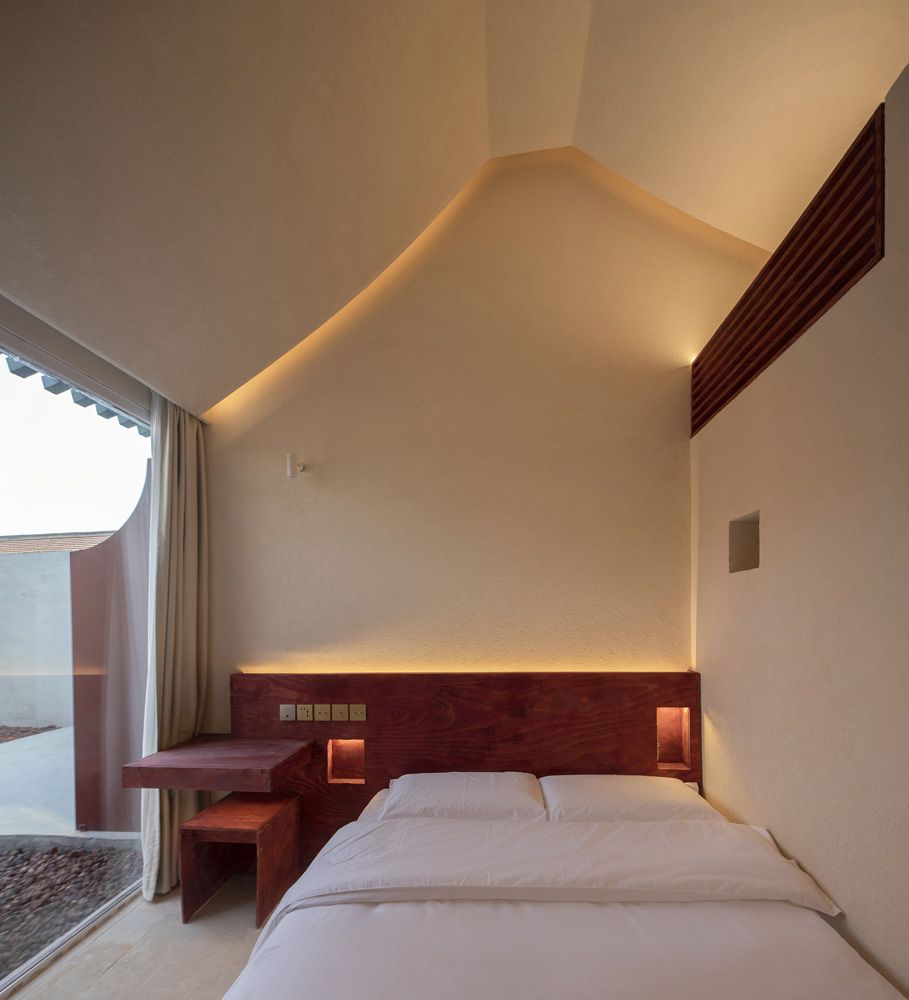
设计手段化解施工困局
Design strategies to resolve construction challenges
这个项目是我们迄今为止最具挑战性的小项目之一。一个令人困扰的问题是业主没有请专业的施工单位,而是雇佣了散工来进行施工。这导致工人的水平和责任心难以掌控,对于项目的完成度造成了很大的困扰。在经历了一系列施工错误之后,我们做出了一个决定:通过设计的手段深入介入施工,尽可能地减少施工方的犯错机会。
This project has been one of the most challenging small-scale projects we have undertaken so far. One major issue that has posed a challenge is that the client did not hire a professional construction company but instead employed laborers for the construction work. This has made it difficult to control the skill level and commitment of the workers, causing significant challenges in terms of the project's completion. After experiencing a series of construction errors, we made a decision to intervene more deeply in the construction process through design means in order to minimize the chances of mistakes by the construction team.
▼透过落地玻璃窗看客房,View of the guest room through the floor-to-ceiling glass window
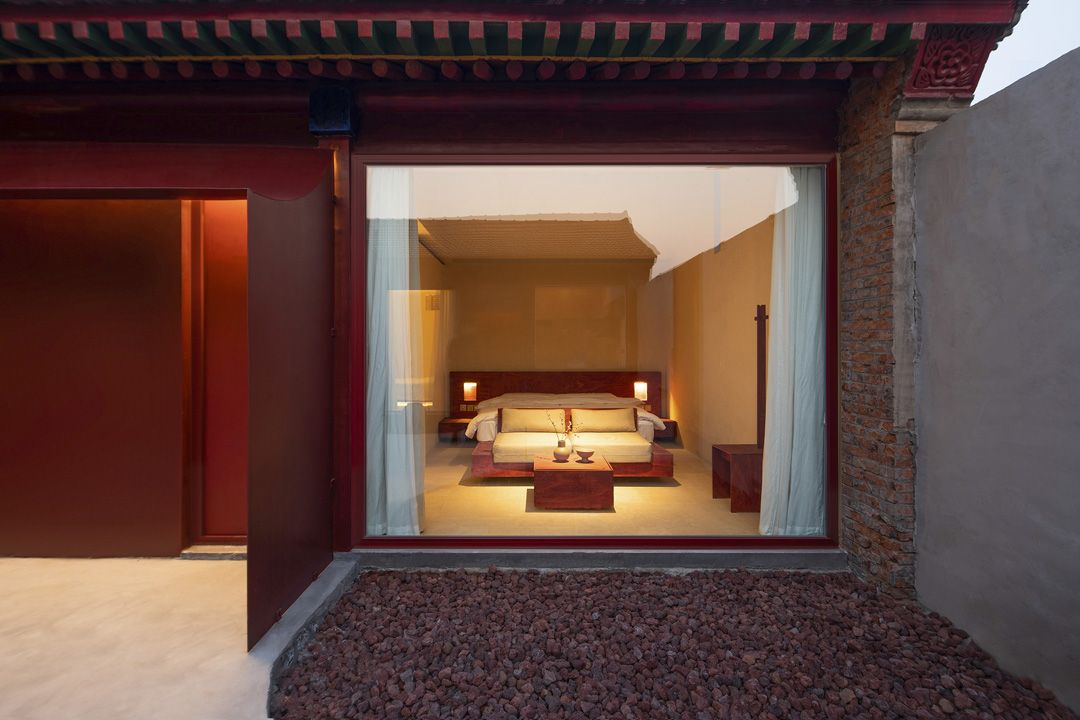
▼室内外的渗透关系,Relationship of permeation between indoors and outdoors
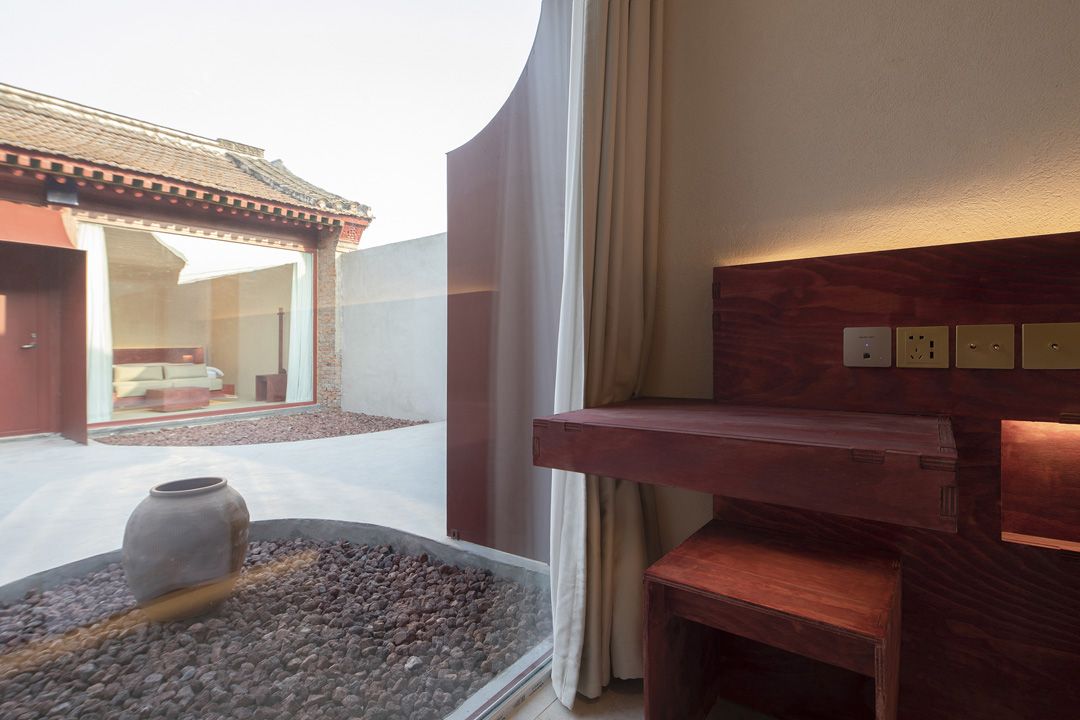
▼室内外的和谐统一,Harmonious unity between indoors and outdoors
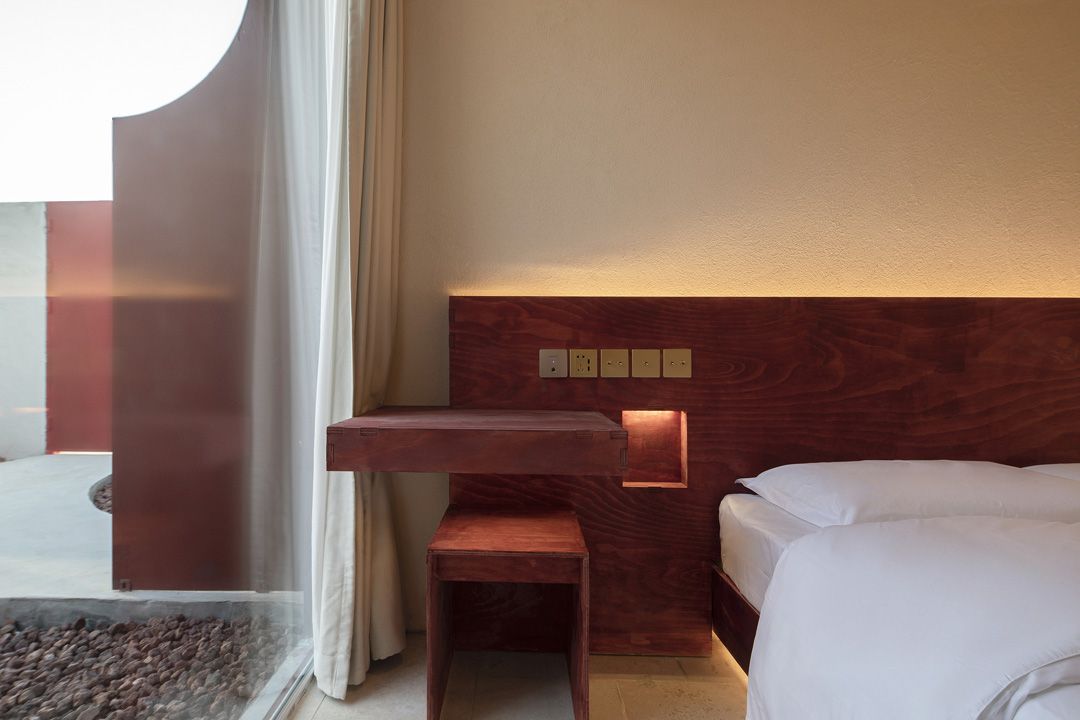
▼由客房内部看向室外,View from the interior of the guest room to the outside

▼由西厢房看向院子,View from the west wing towards the courtyard
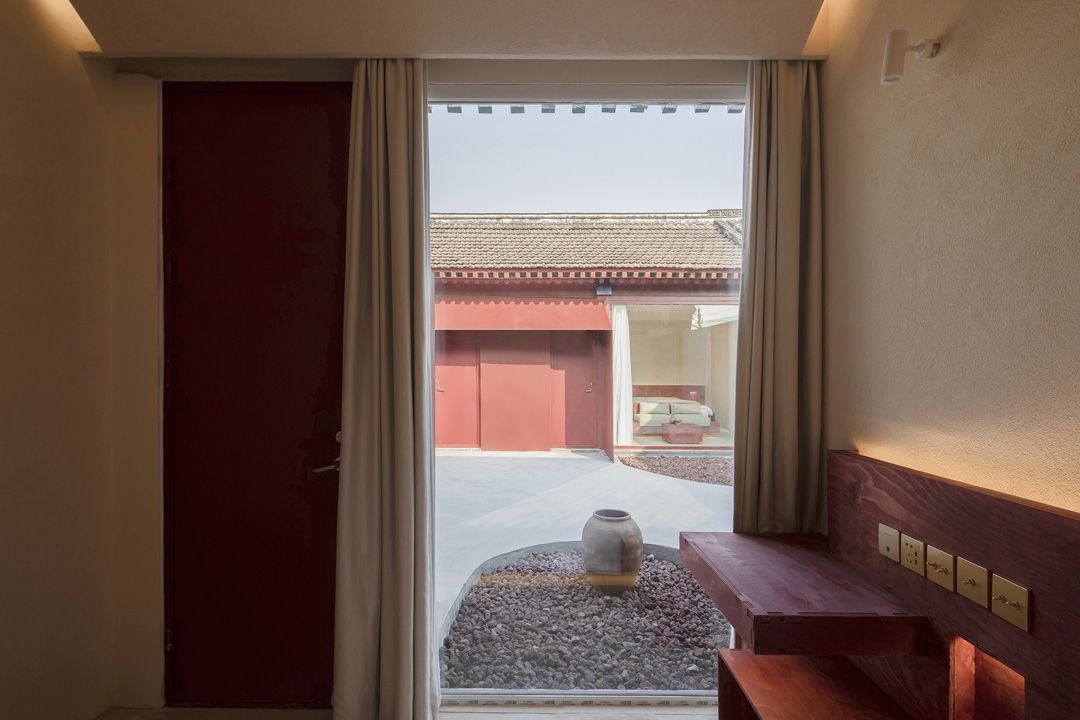
▼由东厢房看向院子,View from the east wing towards the courtyard
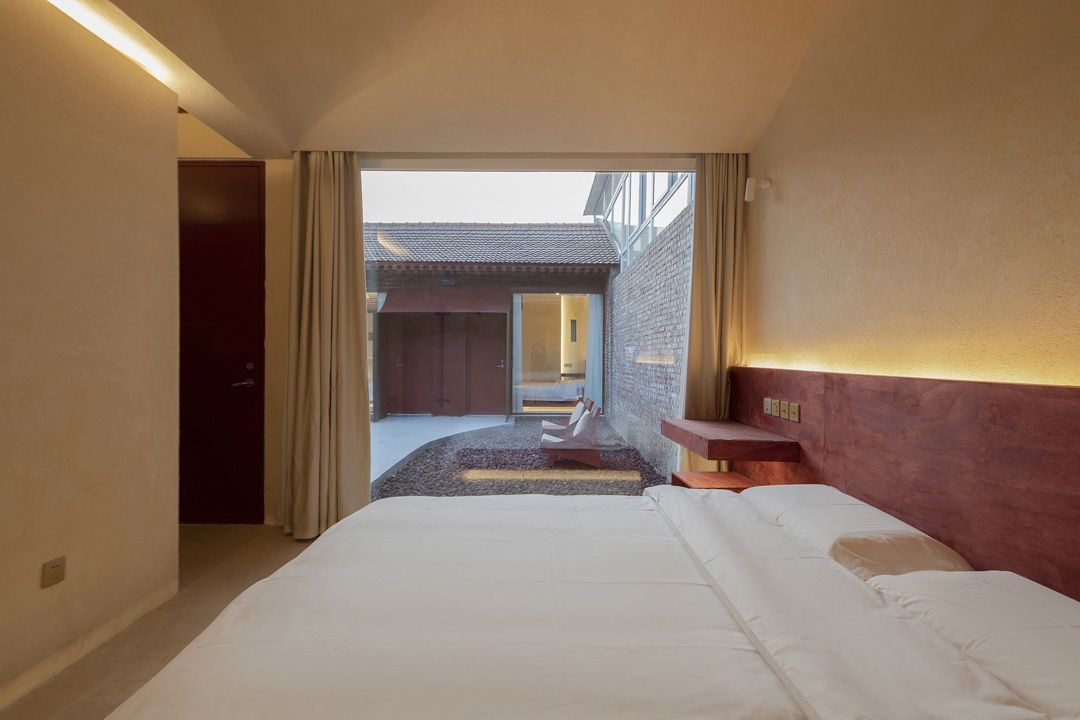
▼窗外的躺椅,Lounge chairs outside the window
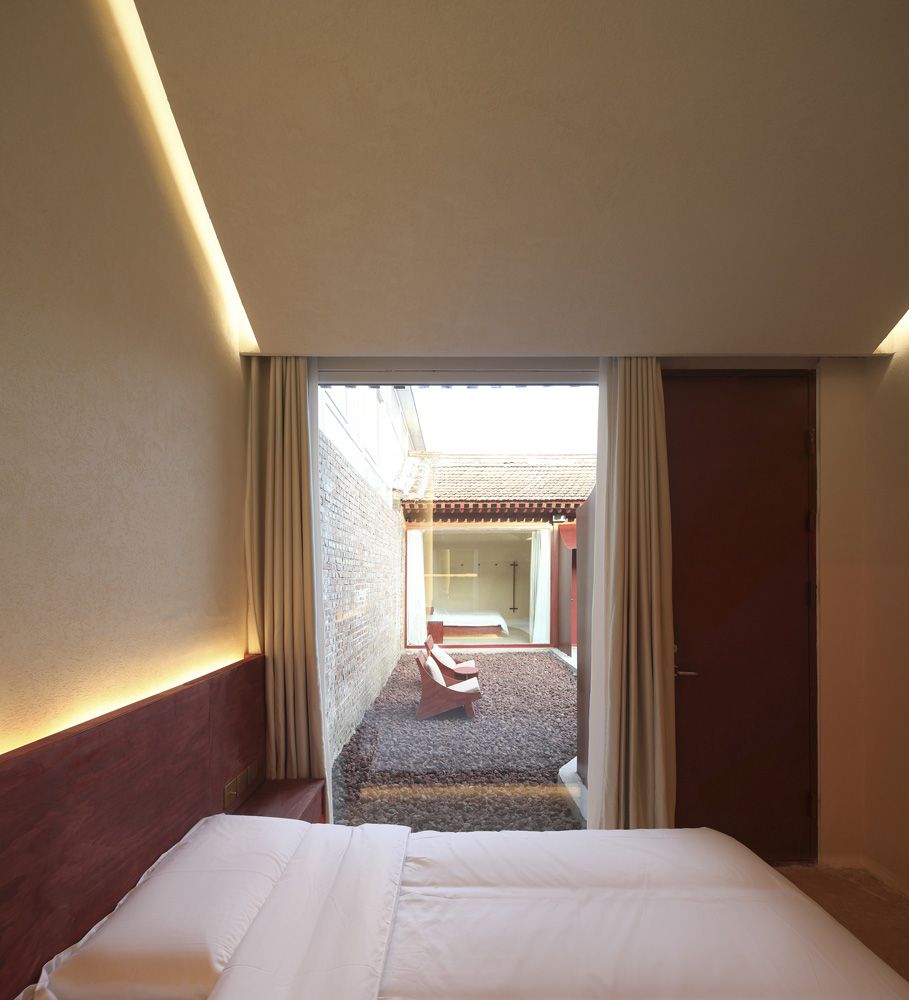
我们将室内所有的家具、柜体等都设计成了预制拼装形式,无论是明显可见的构件还是隐藏在内部的龙骨,每一块木板都被精确地定位在特定的位置上。通过这种方式来解放施工师傅的大脑,只要师傅按照我们提供的拼装图纸进行操作,最终的效果就能与设计图纸契合。这种设计策略不仅减少了施工过程中的错误和不确定性,还提高了施工效率。这也源自于工作室多年来的实践经验和设计手法,将传统榫卯节点简化并应用于家具组装中,不仅仅是为了实现功能性,也是美观和艺术性的表达,以符合项目自身的风格和理念。
We designed all the interior furniture and cabinets to be prefabricated and assembled. Whether they are visible components or hidden framework, every piece of wood is precisely positioned in its designated location. This approach liberates the construction workers' minds, as they simply need to follow the assembly drawings provided by us, ensuring that the final result aligns with the design drawings.
This design strategy not only reduces errors and uncertainties during the construction process but also improves construction efficiency. It stems from years of practical experience and design techniques in our studio. We have simplified traditional joinery techniques and applied them to furniture assembly, not only for functional purposes but also as an expression of aesthetics and artistry, aligning with the style and concept of the project itself.
▼家具拼装轴测动图,furniture assembly isometric animation©atelier d'more
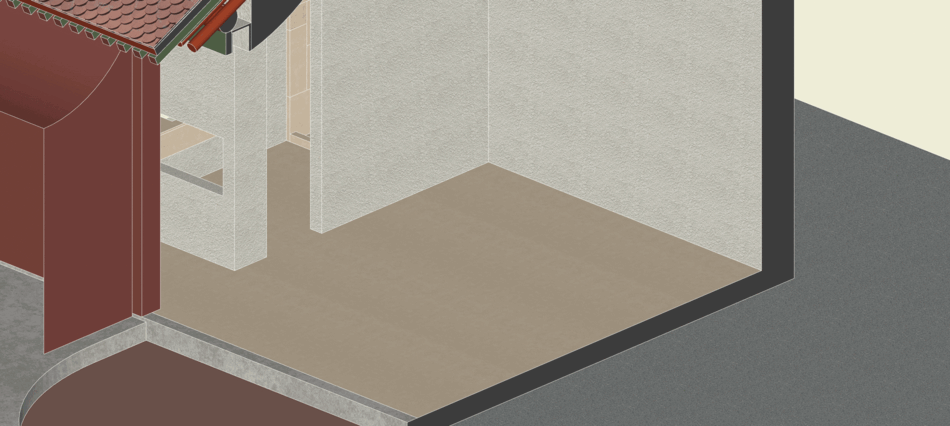
▼客房内的拼装家具,Assembled furniture in the guest room
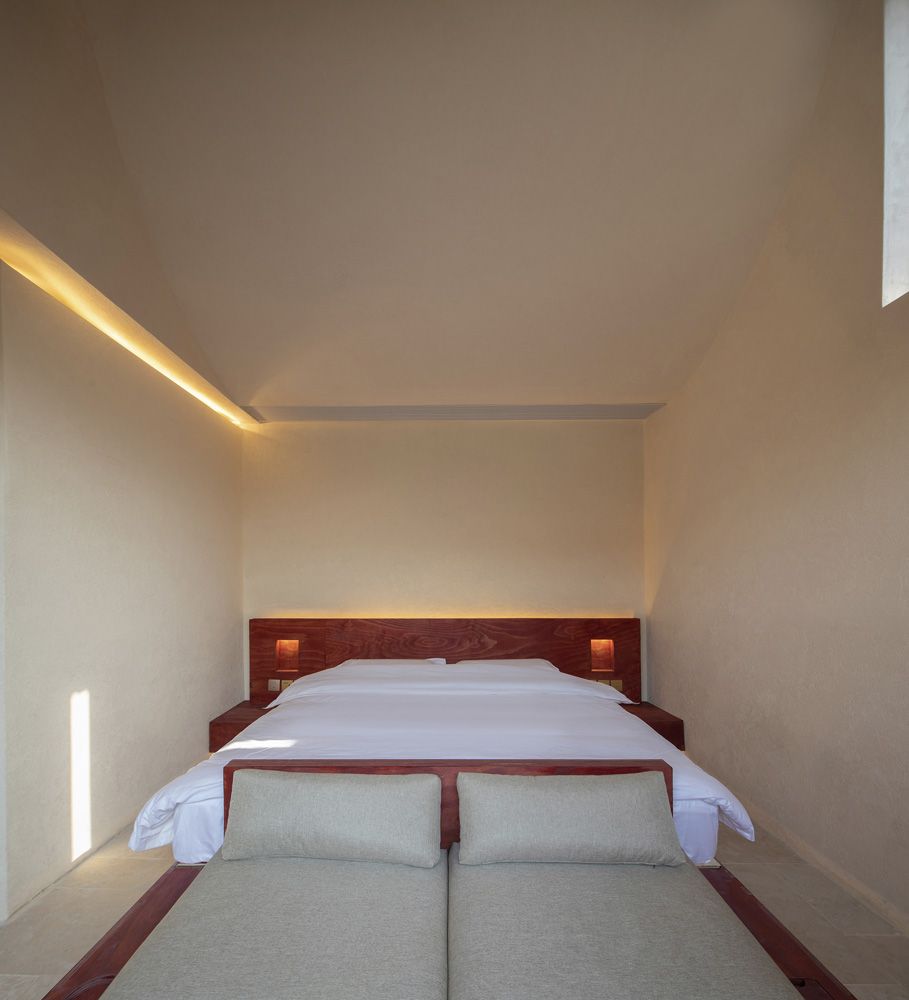
▼悬浮床,Floating bed
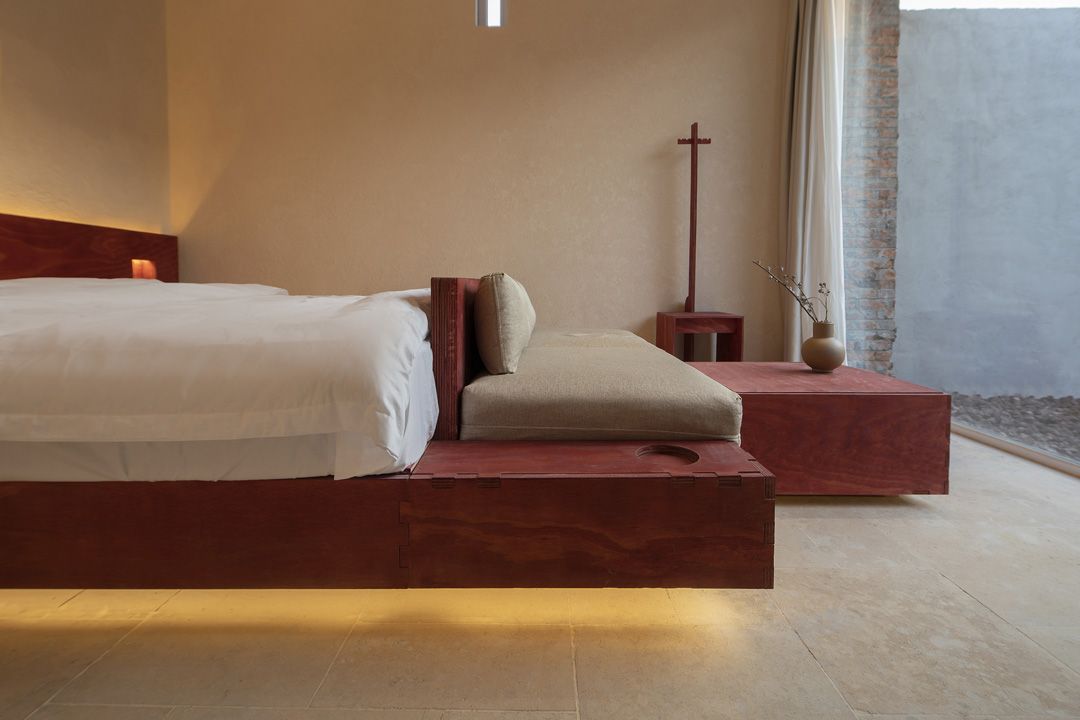
▼客房玄关,Entrance area of the guest room
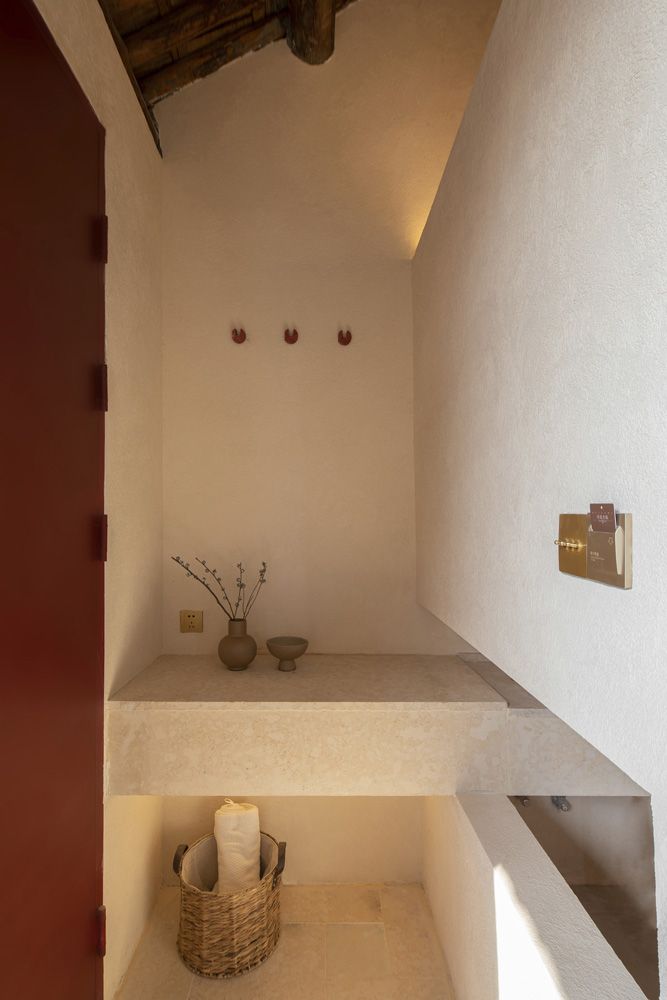
▼特殊定制的木制空调百叶,Customized wooden air conditioning louvers
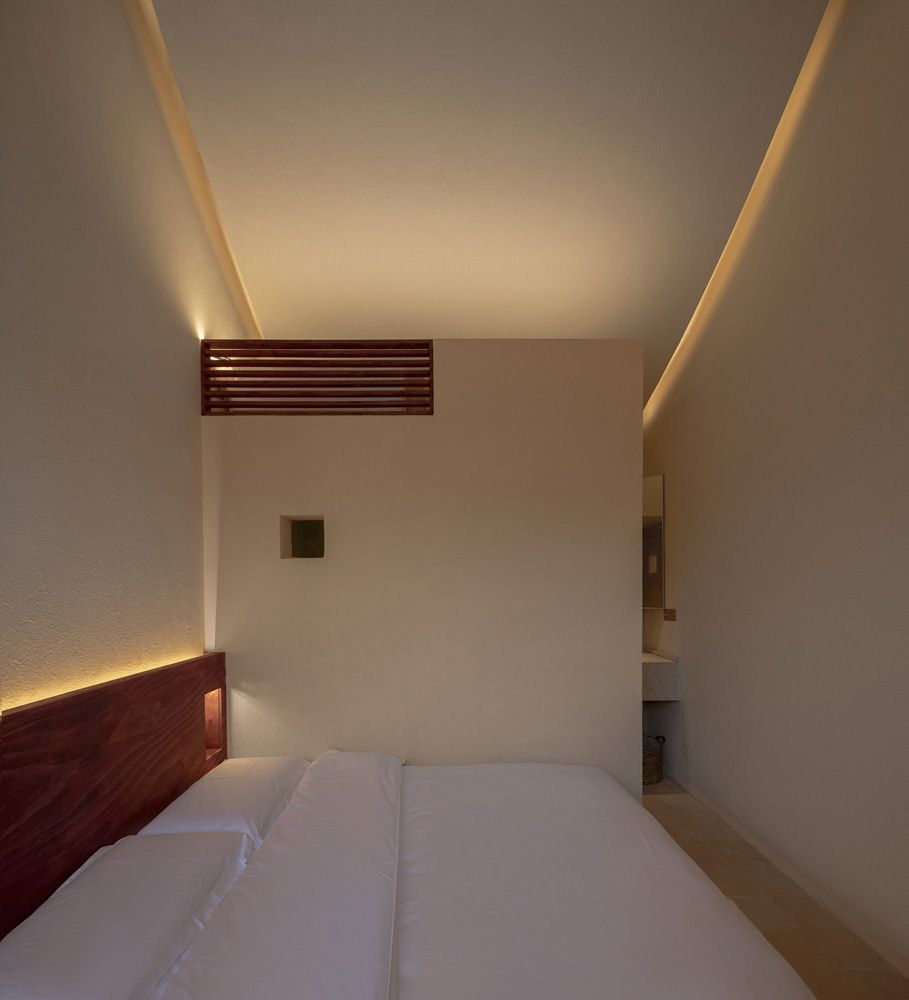
▼为项目设计的挂钩与衣架,Hooks and rack designed for the project


▼原始木屋顶下的卫生间,Bathroom under the original wooden roof
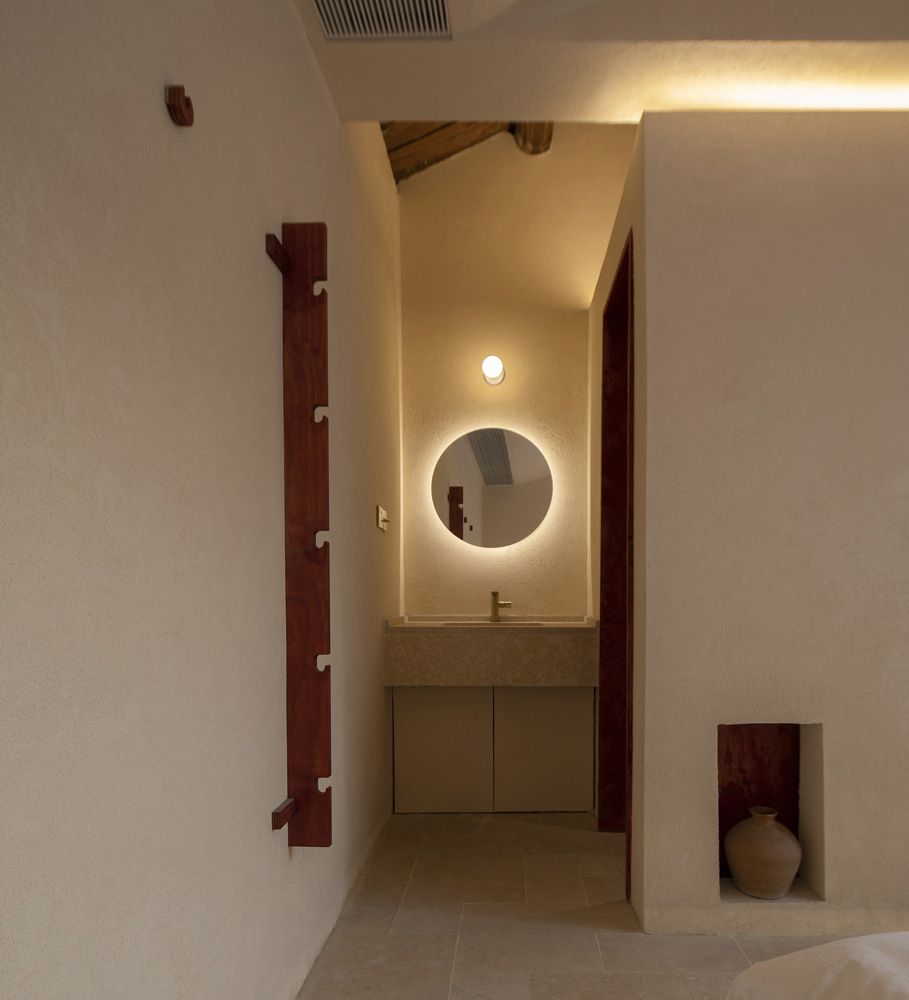
▼西厢房客房卫生间,Bathroom in the guest room of the west wing
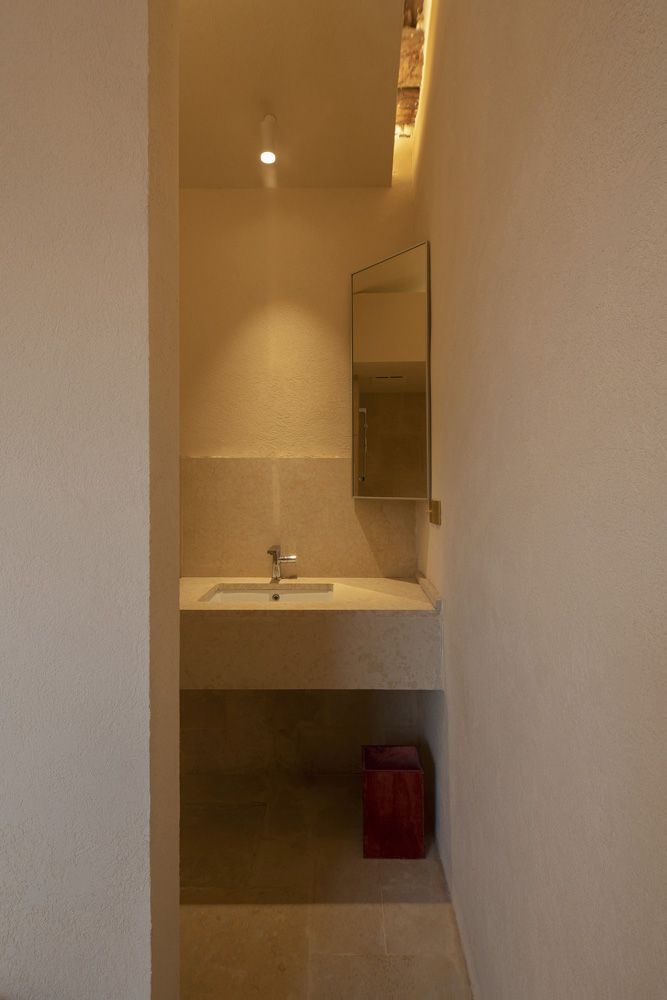
▼洗手台细部,Detail of the washbasin
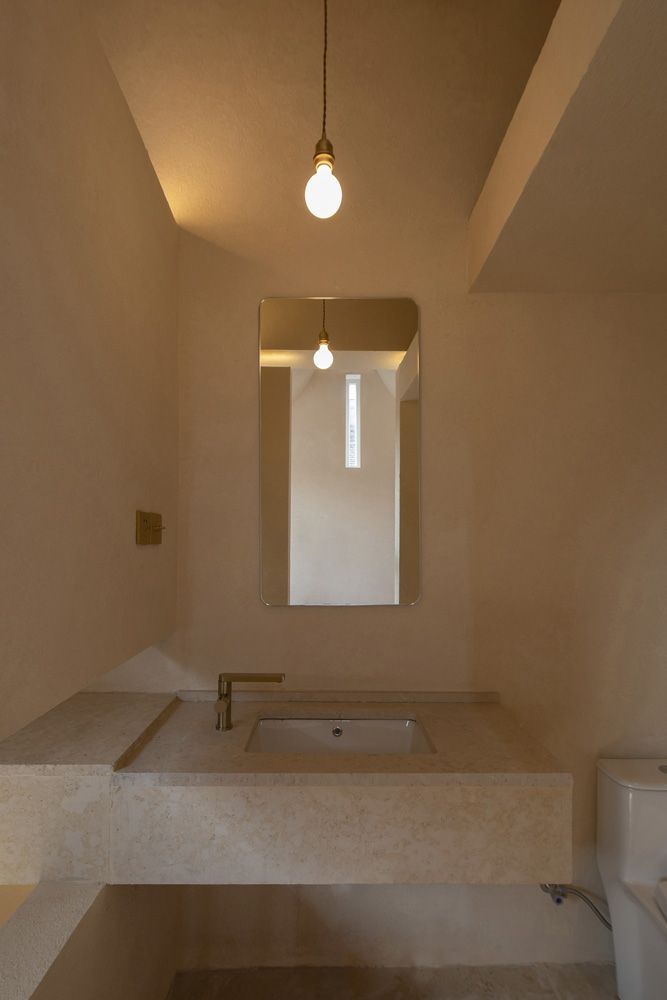
▼延申的洗手台,Extended washbasin
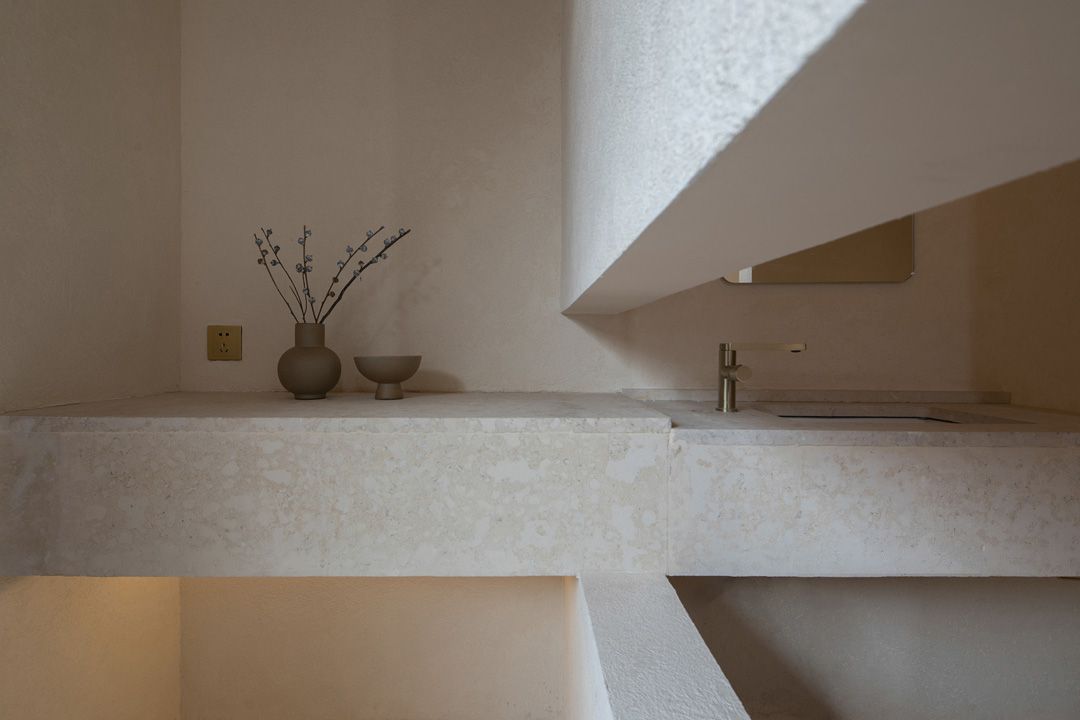
▼自然气息的浴室,Bathroom with a natural touch
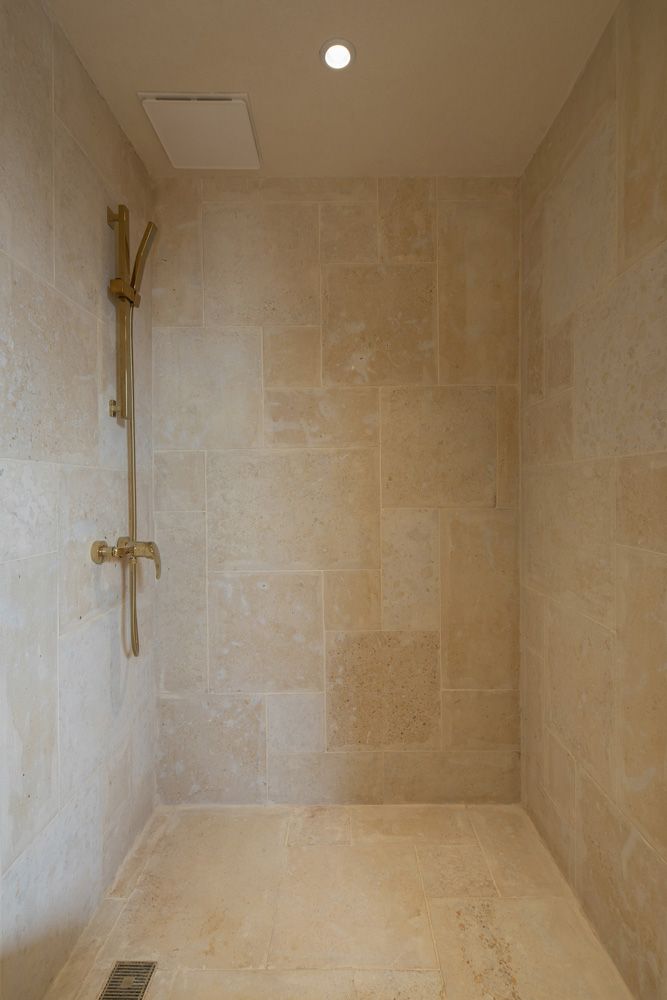
项目信息
项目名称:寸二民宿
Project: Twosome Inn
设计方(建筑/景观/室内/家具设计):多么工作室
Design: Atelier d’More
主创建筑师:盛乐,王维
Chief Architects: Le Sheng, Wei Wang
设计团队:周腾,豆会会,王春浩,赵丁一
Design Team: Teng Zhou, Huihui Dou, Chunhao Wang, Dingyi Zhao
项目地址:北京,中国
Location: Beijing, China
建筑面积:88㎡
Gross Built Area: 88㎡
用地面积:150㎡
Site Area: 150㎡
设计和建成年份:设计时间2021年,建成时间2023年
Design and Completion Year: Designed in 2021, Completed in 2023
摄影版权:多么工作室
Photo Credit: Atelier d’More
|
|
|
|
|
|
|
|
|
凡注明“国际设计网”的所有文章,及本网站上的项目案例,未经本网授权不得转载、摘编或利用其它方式使用。
已经授权者,应在授权范围内使用,并注明“来源:国际设计网”。违反上述声明者,本网将追究其相关法律责任。